Business & Business Environment: A Comprehensive Analysis of Asda
VerifiedAdded on 2024/05/30
|27
|5036
|392
AI Summary
This comprehensive analysis delves into the complexities of the business environment, focusing on Asda as a case study. It explores different types of organizations, their structures, and the interrelationships between organizational functions. The study examines the impact of macro (PESTLE) and micro (SWOT) factors on Asda's business objectives and decision-making processes, providing insights into how these factors influence strategic planning and operational efficiency.
Contribute Materials
Your contribution can guide someone’s learning journey. Share your
documents today.
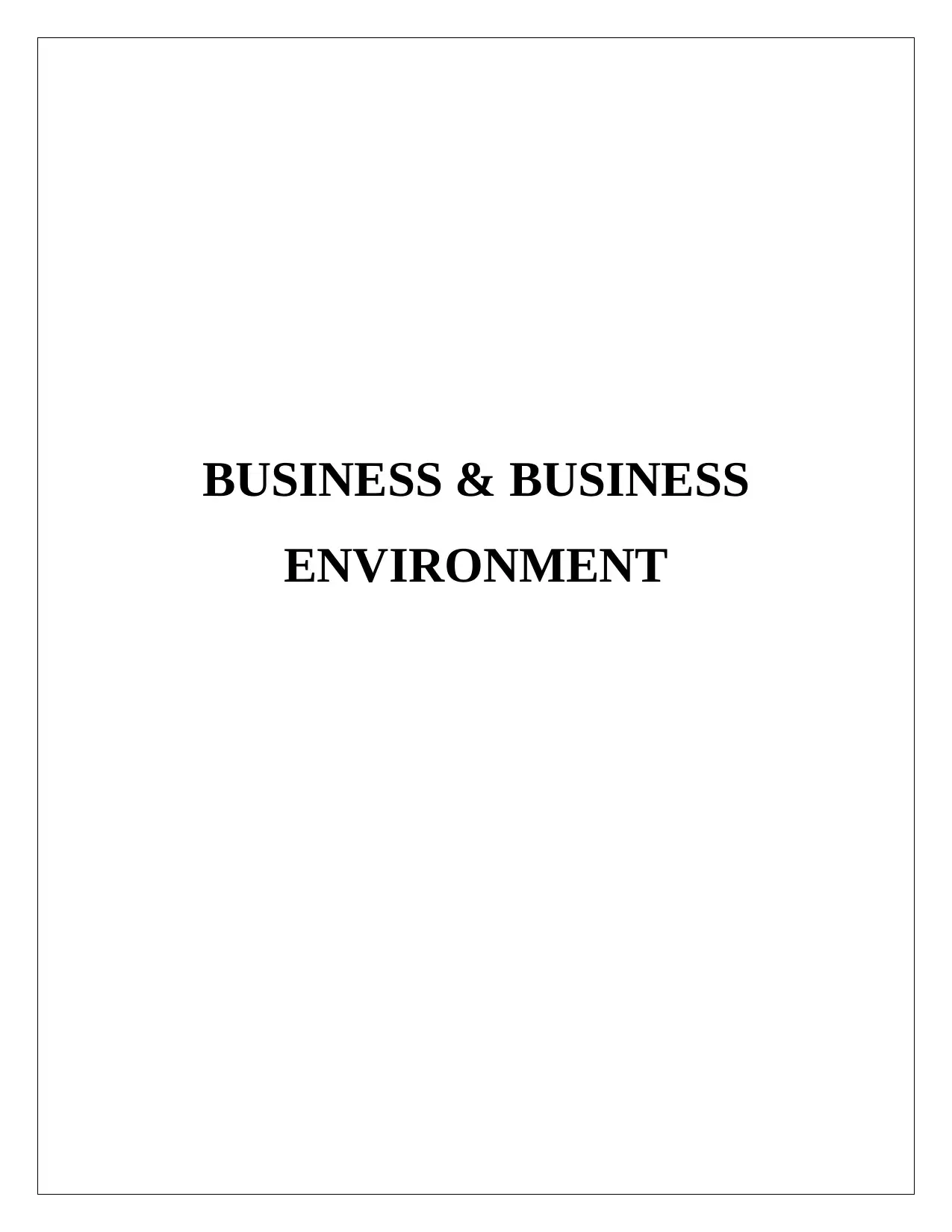
BUSINESS & BUSINESS
ENVIRONMENT
ENVIRONMENT
Secure Best Marks with AI Grader
Need help grading? Try our AI Grader for instant feedback on your assignments.
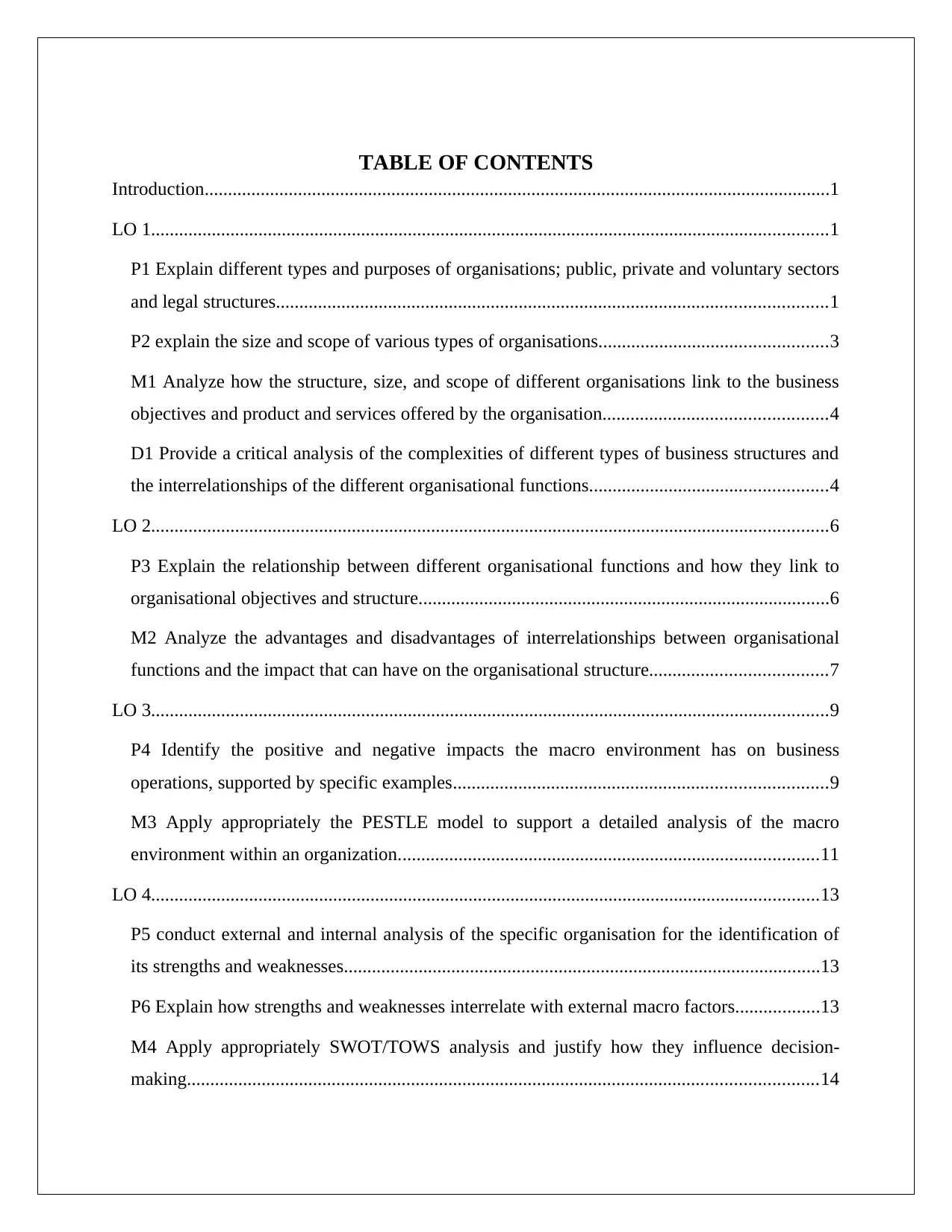
TABLE OF CONTENTS
Introduction......................................................................................................................................1
LO 1.................................................................................................................................................1
P1 Explain different types and purposes of organisations; public, private and voluntary sectors
and legal structures......................................................................................................................1
P2 explain the size and scope of various types of organisations.................................................3
M1 Analyze how the structure, size, and scope of different organisations link to the business
objectives and product and services offered by the organisation................................................4
D1 Provide a critical analysis of the complexities of different types of business structures and
the interrelationships of the different organisational functions...................................................4
LO 2.................................................................................................................................................6
P3 Explain the relationship between different organisational functions and how they link to
organisational objectives and structure........................................................................................6
M2 Analyze the advantages and disadvantages of interrelationships between organisational
functions and the impact that can have on the organisational structure......................................7
LO 3.................................................................................................................................................9
P4 Identify the positive and negative impacts the macro environment has on business
operations, supported by specific examples................................................................................9
M3 Apply appropriately the PESTLE model to support a detailed analysis of the macro
environment within an organization..........................................................................................11
LO 4...............................................................................................................................................13
P5 conduct external and internal analysis of the specific organisation for the identification of
its strengths and weaknesses......................................................................................................13
P6 Explain how strengths and weaknesses interrelate with external macro factors..................13
M4 Apply appropriately SWOT/TOWS analysis and justify how they influence decision-
making.......................................................................................................................................14
Introduction......................................................................................................................................1
LO 1.................................................................................................................................................1
P1 Explain different types and purposes of organisations; public, private and voluntary sectors
and legal structures......................................................................................................................1
P2 explain the size and scope of various types of organisations.................................................3
M1 Analyze how the structure, size, and scope of different organisations link to the business
objectives and product and services offered by the organisation................................................4
D1 Provide a critical analysis of the complexities of different types of business structures and
the interrelationships of the different organisational functions...................................................4
LO 2.................................................................................................................................................6
P3 Explain the relationship between different organisational functions and how they link to
organisational objectives and structure........................................................................................6
M2 Analyze the advantages and disadvantages of interrelationships between organisational
functions and the impact that can have on the organisational structure......................................7
LO 3.................................................................................................................................................9
P4 Identify the positive and negative impacts the macro environment has on business
operations, supported by specific examples................................................................................9
M3 Apply appropriately the PESTLE model to support a detailed analysis of the macro
environment within an organization..........................................................................................11
LO 4...............................................................................................................................................13
P5 conduct external and internal analysis of the specific organisation for the identification of
its strengths and weaknesses......................................................................................................13
P6 Explain how strengths and weaknesses interrelate with external macro factors..................13
M4 Apply appropriately SWOT/TOWS analysis and justify how they influence decision-
making.......................................................................................................................................14
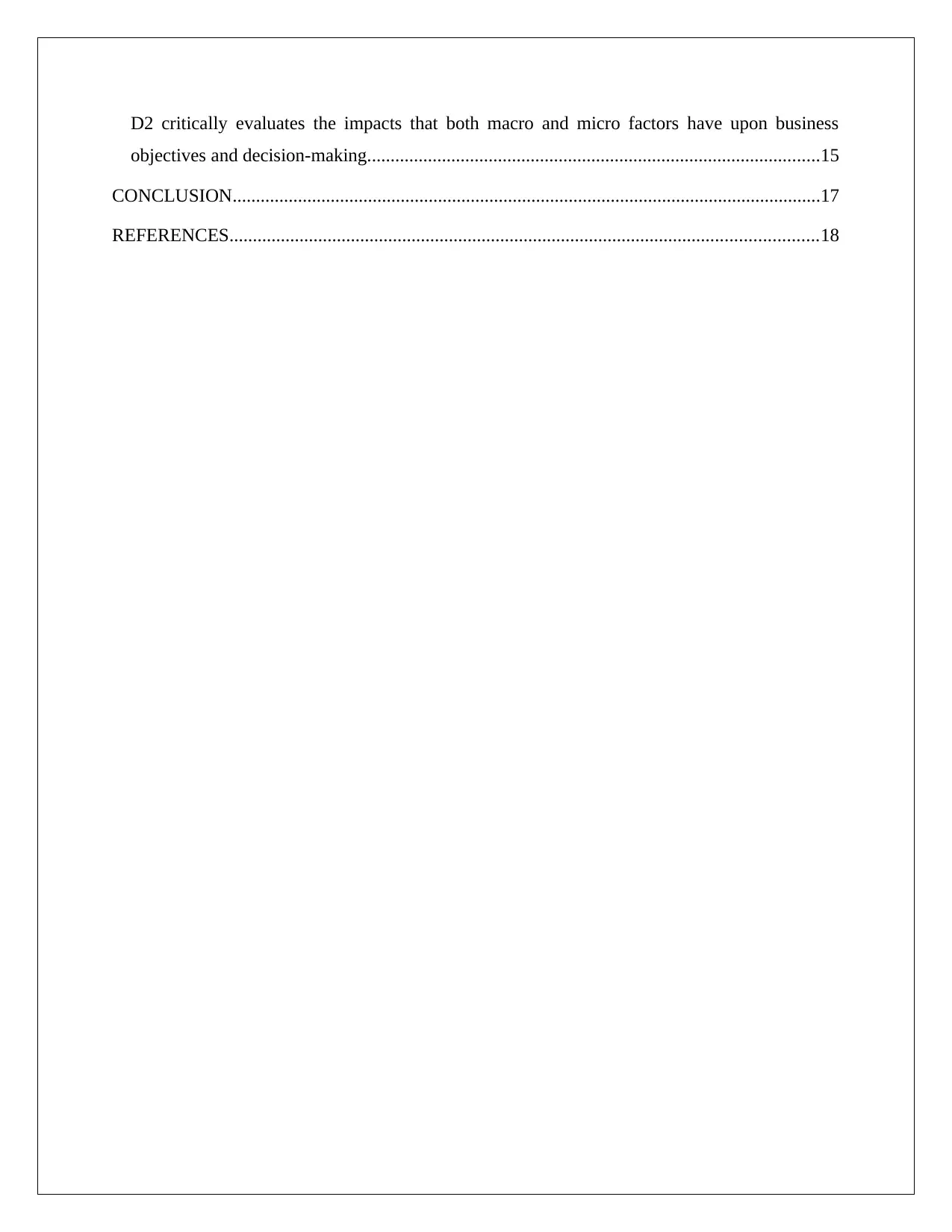
D2 critically evaluates the impacts that both macro and micro factors have upon business
objectives and decision-making.................................................................................................15
CONCLUSION..............................................................................................................................17
REFERENCES..............................................................................................................................18
objectives and decision-making.................................................................................................15
CONCLUSION..............................................................................................................................17
REFERENCES..............................................................................................................................18
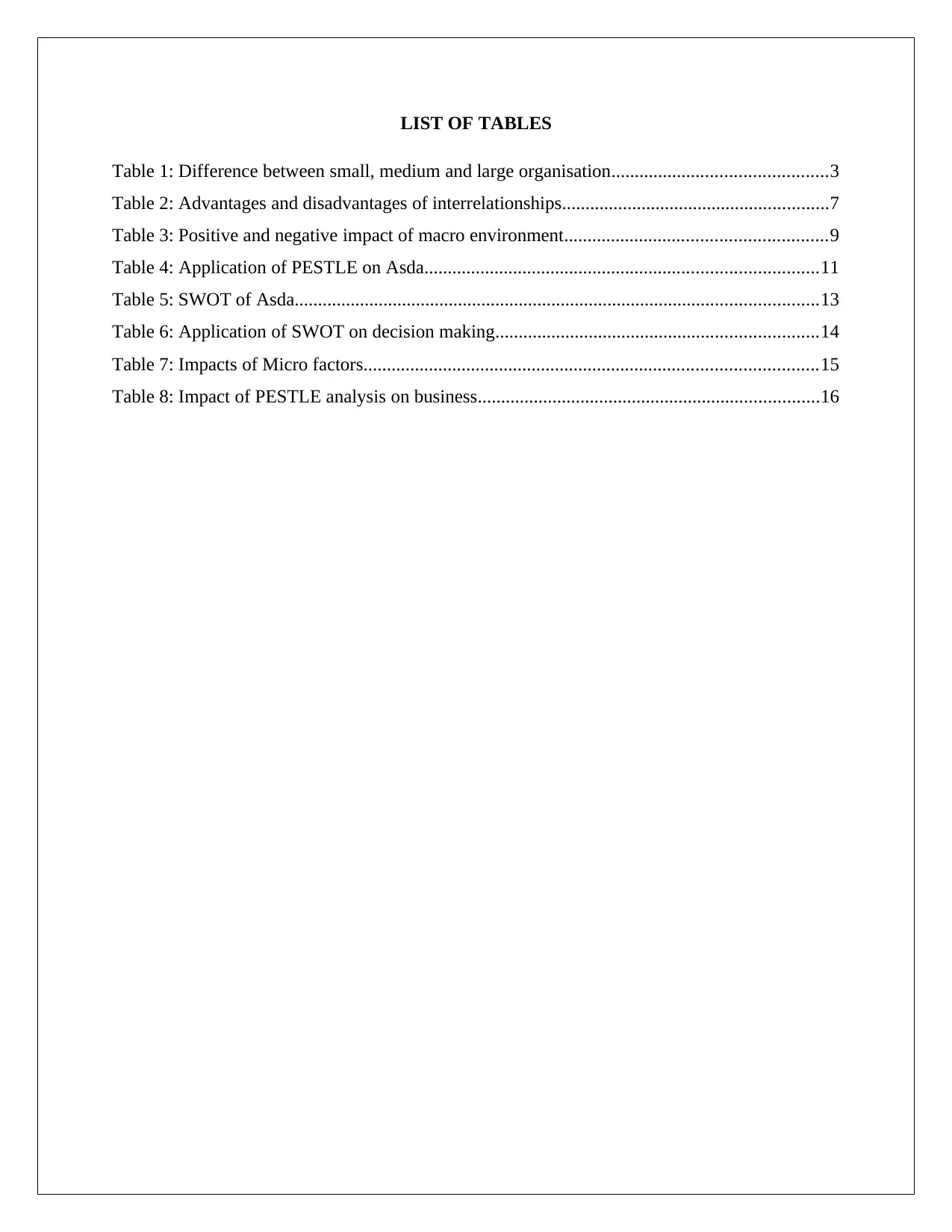
LIST OF TABLES
Table 1: Difference between small, medium and large organisation..............................................3
Table 2: Advantages and disadvantages of interrelationships.........................................................7
Table 3: Positive and negative impact of macro environment........................................................9
Table 4: Application of PESTLE on Asda....................................................................................11
Table 5: SWOT of Asda................................................................................................................13
Table 6: Application of SWOT on decision making.....................................................................14
Table 7: Impacts of Micro factors.................................................................................................15
Table 8: Impact of PESTLE analysis on business.........................................................................16
Table 1: Difference between small, medium and large organisation..............................................3
Table 2: Advantages and disadvantages of interrelationships.........................................................7
Table 3: Positive and negative impact of macro environment........................................................9
Table 4: Application of PESTLE on Asda....................................................................................11
Table 5: SWOT of Asda................................................................................................................13
Table 6: Application of SWOT on decision making.....................................................................14
Table 7: Impacts of Micro factors.................................................................................................15
Table 8: Impact of PESTLE analysis on business.........................................................................16
Secure Best Marks with AI Grader
Need help grading? Try our AI Grader for instant feedback on your assignments.

LIST OF FIGURES
Figure 1: Different types of organisation.........................................................................................1
Figure 2: Legal structure of organisation.........................................................................................2
Figure 3: Different functional areas of business..............................................................................6
Figure 4: Pestle analysis framework..............................................................................................11
Figure 5: Interrelationships of SWOT and macro factors.............................................................14
Figure 6: PESTLE impacts............................................................................................................16
Figure 1: Different types of organisation.........................................................................................1
Figure 2: Legal structure of organisation.........................................................................................2
Figure 3: Different functional areas of business..............................................................................6
Figure 4: Pestle analysis framework..............................................................................................11
Figure 5: Interrelationships of SWOT and macro factors.............................................................14
Figure 6: PESTLE impacts............................................................................................................16

Introduction
Organisation works for earning profits and maximising the profits and also for enhancing its
customer loyalty. But these objectives achievement is not so much easy it requires huge efforts
and resources in terms of analysing the environment in which organisation operates. Business
environment has two categories macro environment and micro environment. These two
environments have lots of factors as SWOT and PESTLE these elements are so important to
analyse as they give the right and current position of the organisation. And all the tools which
give proper idea about these elements those tools are also very important to know.
1
Organisation works for earning profits and maximising the profits and also for enhancing its
customer loyalty. But these objectives achievement is not so much easy it requires huge efforts
and resources in terms of analysing the environment in which organisation operates. Business
environment has two categories macro environment and micro environment. These two
environments have lots of factors as SWOT and PESTLE these elements are so important to
analyse as they give the right and current position of the organisation. And all the tools which
give proper idea about these elements those tools are also very important to know.
1
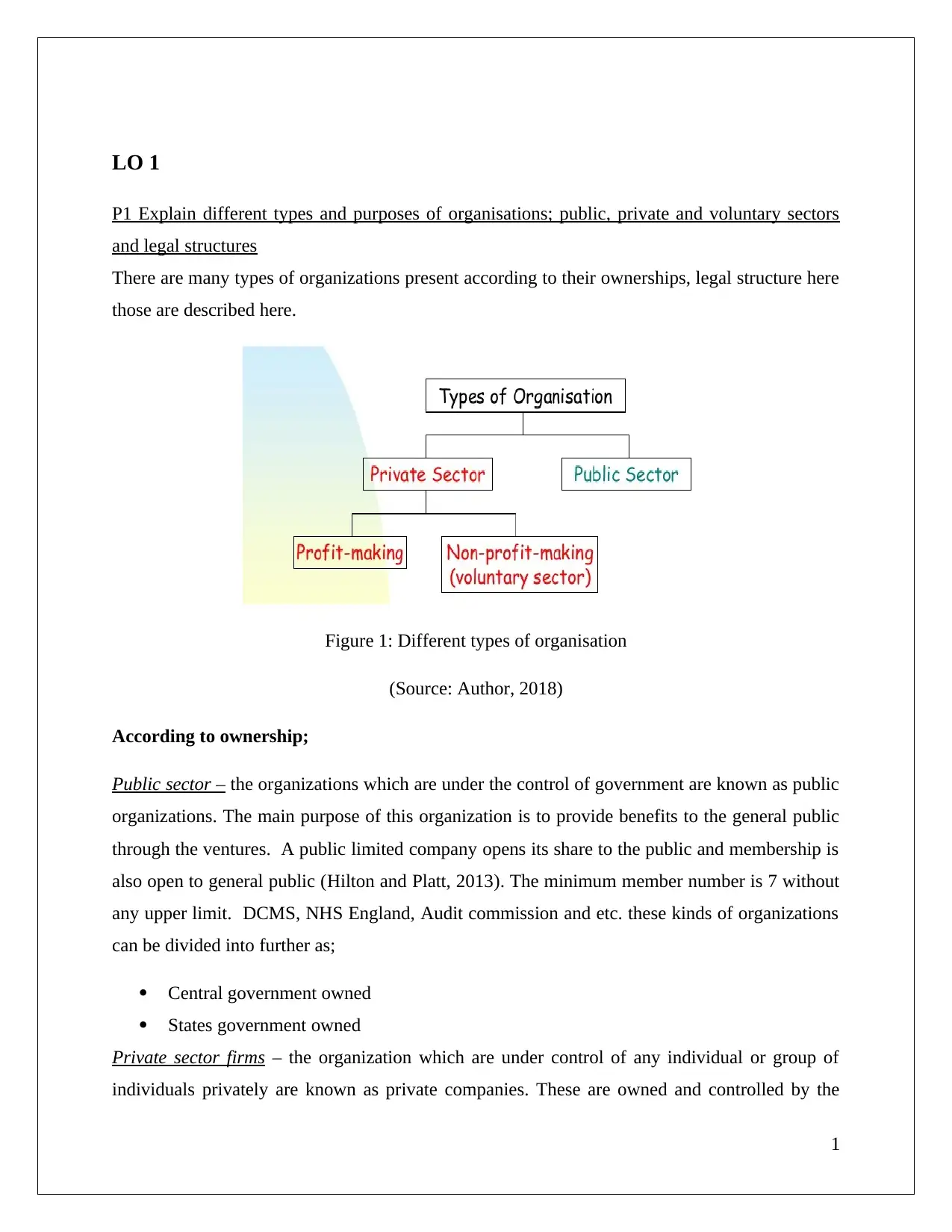
LO 1
P1 Explain different types and purposes of organisations; public, private and voluntary sectors
and legal structures
There are many types of organizations present according to their ownerships, legal structure here
those are described here.
Figure 1: Different types of organisation
(Source: Author, 2018)
According to ownership;
Public sector – the organizations which are under the control of government are known as public
organizations. The main purpose of this organization is to provide benefits to the general public
through the ventures. A public limited company opens its share to the public and membership is
also open to general public (Hilton and Platt, 2013). The minimum member number is 7 without
any upper limit. DCMS, NHS England, Audit commission and etc. these kinds of organizations
can be divided into further as;
Central government owned
States government owned
Private sector firms – the organization which are under control of any individual or group of
individuals privately are known as private companies. These are owned and controlled by the
1
P1 Explain different types and purposes of organisations; public, private and voluntary sectors
and legal structures
There are many types of organizations present according to their ownerships, legal structure here
those are described here.
Figure 1: Different types of organisation
(Source: Author, 2018)
According to ownership;
Public sector – the organizations which are under the control of government are known as public
organizations. The main purpose of this organization is to provide benefits to the general public
through the ventures. A public limited company opens its share to the public and membership is
also open to general public (Hilton and Platt, 2013). The minimum member number is 7 without
any upper limit. DCMS, NHS England, Audit commission and etc. these kinds of organizations
can be divided into further as;
Central government owned
States government owned
Private sector firms – the organization which are under control of any individual or group of
individuals privately are known as private companies. These are owned and controlled by the
1
Paraphrase This Document
Need a fresh take? Get an instant paraphrase of this document with our AI Paraphraser
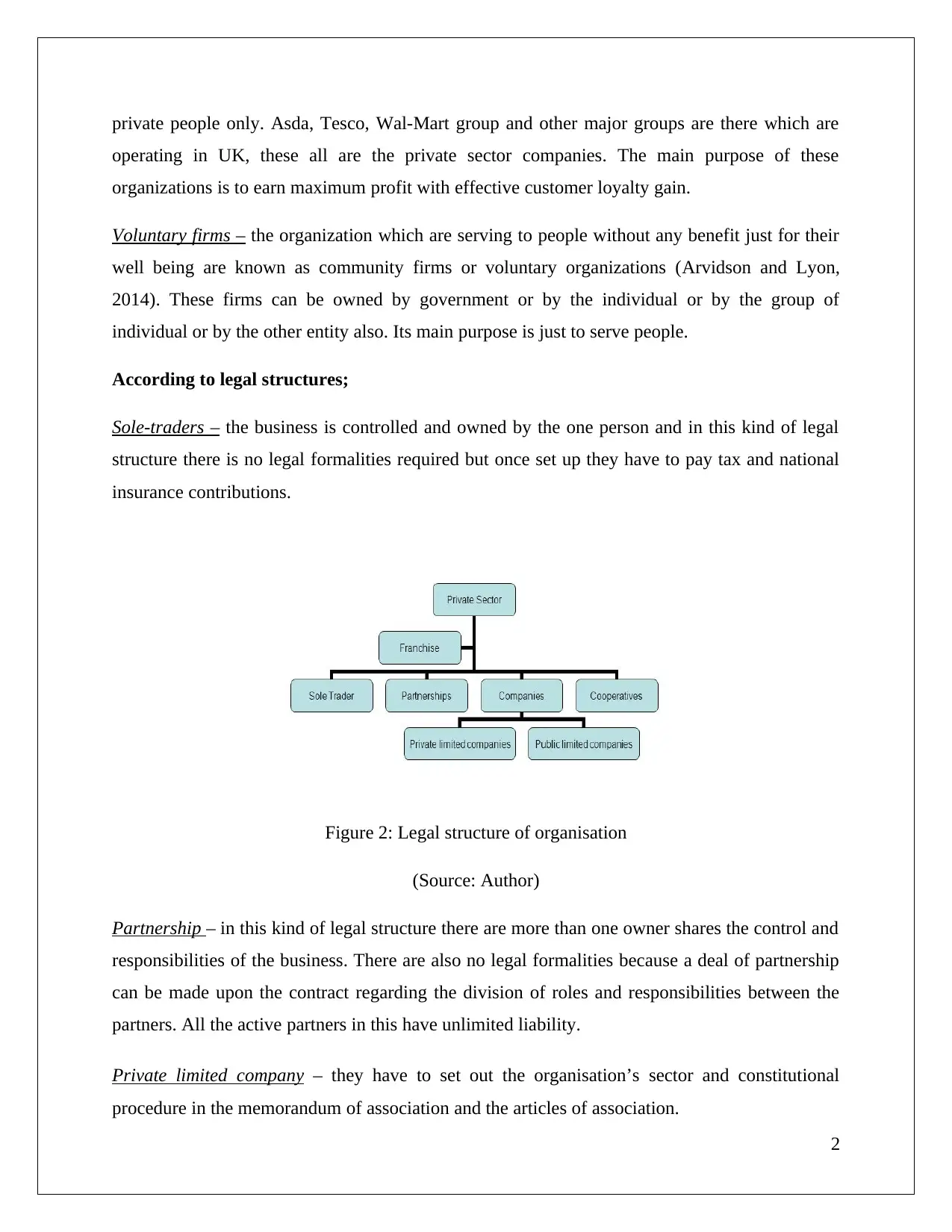
private people only. Asda, Tesco, Wal-Mart group and other major groups are there which are
operating in UK, these all are the private sector companies. The main purpose of these
organizations is to earn maximum profit with effective customer loyalty gain.
Voluntary firms – the organization which are serving to people without any benefit just for their
well being are known as community firms or voluntary organizations (Arvidson and Lyon,
2014). These firms can be owned by government or by the individual or by the group of
individual or by the other entity also. Its main purpose is just to serve people.
According to legal structures;
Sole-traders – the business is controlled and owned by the one person and in this kind of legal
structure there is no legal formalities required but once set up they have to pay tax and national
insurance contributions.
Figure 2: Legal structure of organisation
(Source: Author)
Partnership – in this kind of legal structure there are more than one owner shares the control and
responsibilities of the business. There are also no legal formalities because a deal of partnership
can be made upon the contract regarding the division of roles and responsibilities between the
partners. All the active partners in this have unlimited liability.
Private limited company – they have to set out the organisation’s sector and constitutional
procedure in the memorandum of association and the articles of association.
2
operating in UK, these all are the private sector companies. The main purpose of these
organizations is to earn maximum profit with effective customer loyalty gain.
Voluntary firms – the organization which are serving to people without any benefit just for their
well being are known as community firms or voluntary organizations (Arvidson and Lyon,
2014). These firms can be owned by government or by the individual or by the group of
individual or by the other entity also. Its main purpose is just to serve people.
According to legal structures;
Sole-traders – the business is controlled and owned by the one person and in this kind of legal
structure there is no legal formalities required but once set up they have to pay tax and national
insurance contributions.
Figure 2: Legal structure of organisation
(Source: Author)
Partnership – in this kind of legal structure there are more than one owner shares the control and
responsibilities of the business. There are also no legal formalities because a deal of partnership
can be made upon the contract regarding the division of roles and responsibilities between the
partners. All the active partners in this have unlimited liability.
Private limited company – they have to set out the organisation’s sector and constitutional
procedure in the memorandum of association and the articles of association.
2
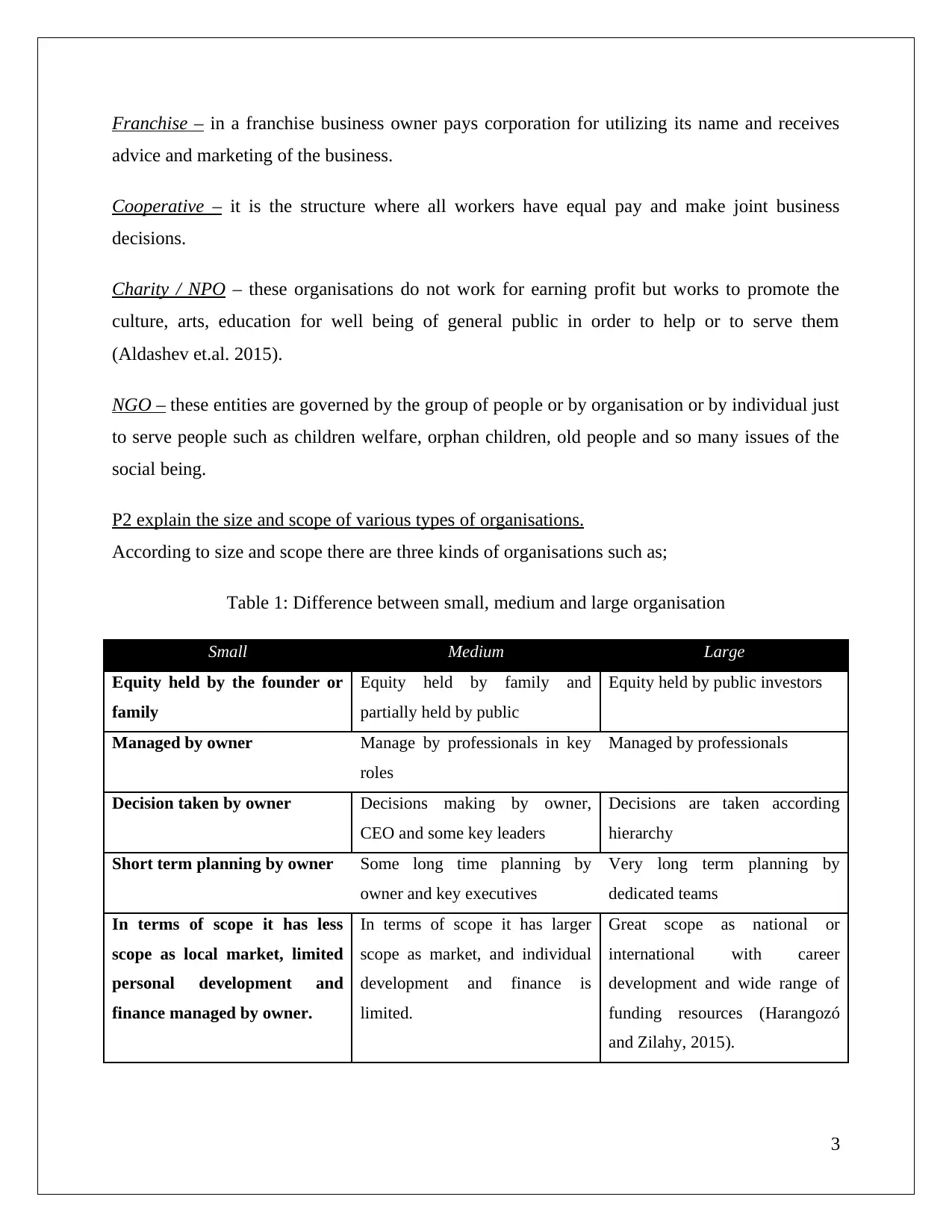
Franchise – in a franchise business owner pays corporation for utilizing its name and receives
advice and marketing of the business.
Cooperative – it is the structure where all workers have equal pay and make joint business
decisions.
Charity / NPO – these organisations do not work for earning profit but works to promote the
culture, arts, education for well being of general public in order to help or to serve them
(Aldashev et.al. 2015).
NGO – these entities are governed by the group of people or by organisation or by individual just
to serve people such as children welfare, orphan children, old people and so many issues of the
social being.
P2 explain the size and scope of various types of organisations.
According to size and scope there are three kinds of organisations such as;
Table 1: Difference between small, medium and large organisation
Small Medium Large
Equity held by the founder or
family
Equity held by family and
partially held by public
Equity held by public investors
Managed by owner Manage by professionals in key
roles
Managed by professionals
Decision taken by owner Decisions making by owner,
CEO and some key leaders
Decisions are taken according
hierarchy
Short term planning by owner Some long time planning by
owner and key executives
Very long term planning by
dedicated teams
In terms of scope it has less
scope as local market, limited
personal development and
finance managed by owner.
In terms of scope it has larger
scope as market, and individual
development and finance is
limited.
Great scope as national or
international with career
development and wide range of
funding resources (Harangozó
and Zilahy, 2015).
3
advice and marketing of the business.
Cooperative – it is the structure where all workers have equal pay and make joint business
decisions.
Charity / NPO – these organisations do not work for earning profit but works to promote the
culture, arts, education for well being of general public in order to help or to serve them
(Aldashev et.al. 2015).
NGO – these entities are governed by the group of people or by organisation or by individual just
to serve people such as children welfare, orphan children, old people and so many issues of the
social being.
P2 explain the size and scope of various types of organisations.
According to size and scope there are three kinds of organisations such as;
Table 1: Difference between small, medium and large organisation
Small Medium Large
Equity held by the founder or
family
Equity held by family and
partially held by public
Equity held by public investors
Managed by owner Manage by professionals in key
roles
Managed by professionals
Decision taken by owner Decisions making by owner,
CEO and some key leaders
Decisions are taken according
hierarchy
Short term planning by owner Some long time planning by
owner and key executives
Very long term planning by
dedicated teams
In terms of scope it has less
scope as local market, limited
personal development and
finance managed by owner.
In terms of scope it has larger
scope as market, and individual
development and finance is
limited.
Great scope as national or
international with career
development and wide range of
funding resources (Harangozó
and Zilahy, 2015).
3
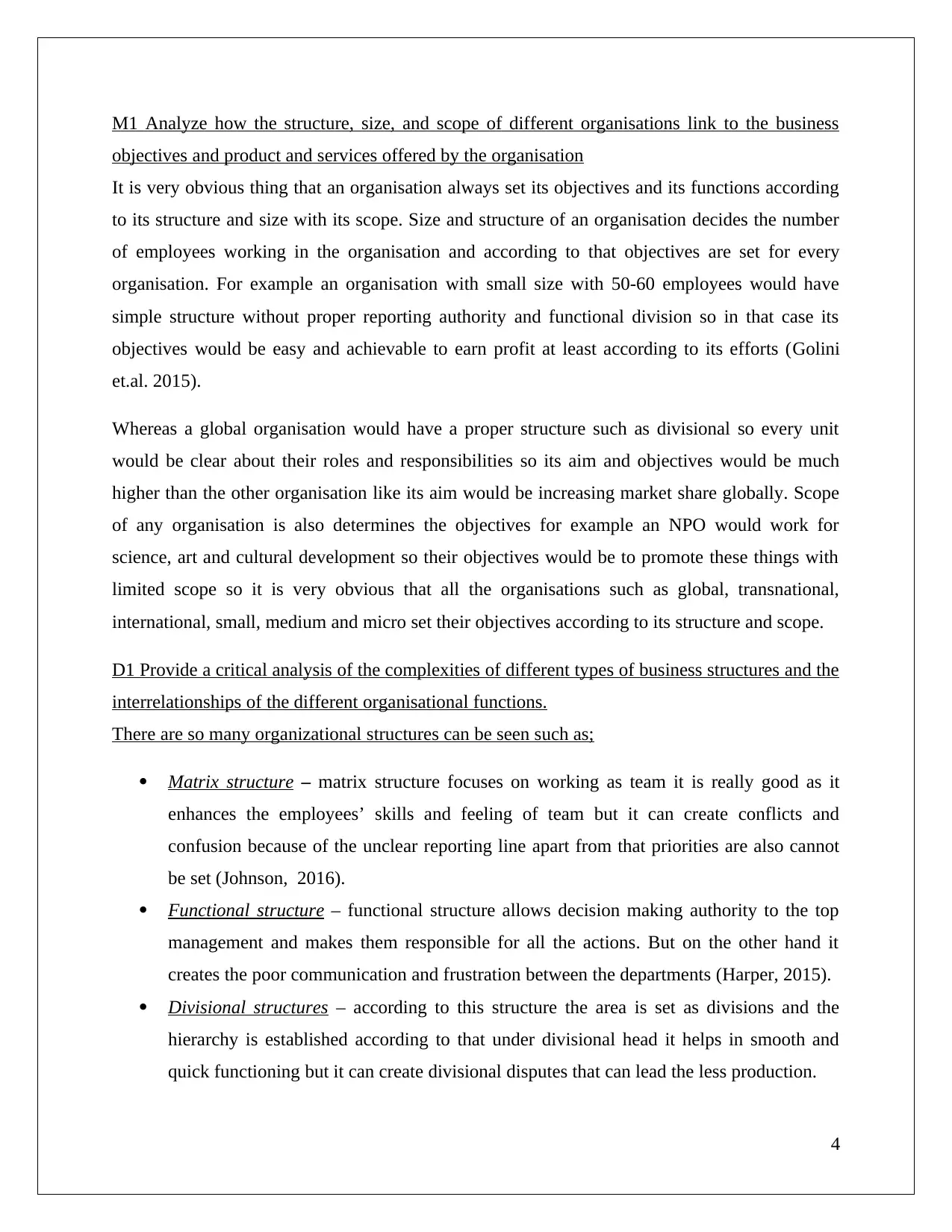
M1 Analyze how the structure, size, and scope of different organisations link to the business
objectives and product and services offered by the organisation
It is very obvious thing that an organisation always set its objectives and its functions according
to its structure and size with its scope. Size and structure of an organisation decides the number
of employees working in the organisation and according to that objectives are set for every
organisation. For example an organisation with small size with 50-60 employees would have
simple structure without proper reporting authority and functional division so in that case its
objectives would be easy and achievable to earn profit at least according to its efforts (Golini
et.al. 2015).
Whereas a global organisation would have a proper structure such as divisional so every unit
would be clear about their roles and responsibilities so its aim and objectives would be much
higher than the other organisation like its aim would be increasing market share globally. Scope
of any organisation is also determines the objectives for example an NPO would work for
science, art and cultural development so their objectives would be to promote these things with
limited scope so it is very obvious that all the organisations such as global, transnational,
international, small, medium and micro set their objectives according to its structure and scope.
D1 Provide a critical analysis of the complexities of different types of business structures and the
interrelationships of the different organisational functions.
There are so many organizational structures can be seen such as;
Matrix structure – matrix structure focuses on working as team it is really good as it
enhances the employees’ skills and feeling of team but it can create conflicts and
confusion because of the unclear reporting line apart from that priorities are also cannot
be set (Johnson, 2016).
Functional structure – functional structure allows decision making authority to the top
management and makes them responsible for all the actions. But on the other hand it
creates the poor communication and frustration between the departments (Harper, 2015).
Divisional structures – according to this structure the area is set as divisions and the
hierarchy is established according to that under divisional head it helps in smooth and
quick functioning but it can create divisional disputes that can lead the less production.
4
objectives and product and services offered by the organisation
It is very obvious thing that an organisation always set its objectives and its functions according
to its structure and size with its scope. Size and structure of an organisation decides the number
of employees working in the organisation and according to that objectives are set for every
organisation. For example an organisation with small size with 50-60 employees would have
simple structure without proper reporting authority and functional division so in that case its
objectives would be easy and achievable to earn profit at least according to its efforts (Golini
et.al. 2015).
Whereas a global organisation would have a proper structure such as divisional so every unit
would be clear about their roles and responsibilities so its aim and objectives would be much
higher than the other organisation like its aim would be increasing market share globally. Scope
of any organisation is also determines the objectives for example an NPO would work for
science, art and cultural development so their objectives would be to promote these things with
limited scope so it is very obvious that all the organisations such as global, transnational,
international, small, medium and micro set their objectives according to its structure and scope.
D1 Provide a critical analysis of the complexities of different types of business structures and the
interrelationships of the different organisational functions.
There are so many organizational structures can be seen such as;
Matrix structure – matrix structure focuses on working as team it is really good as it
enhances the employees’ skills and feeling of team but it can create conflicts and
confusion because of the unclear reporting line apart from that priorities are also cannot
be set (Johnson, 2016).
Functional structure – functional structure allows decision making authority to the top
management and makes them responsible for all the actions. But on the other hand it
creates the poor communication and frustration between the departments (Harper, 2015).
Divisional structures – according to this structure the area is set as divisions and the
hierarchy is established according to that under divisional head it helps in smooth and
quick functioning but it can create divisional disputes that can lead the less production.
4
Secure Best Marks with AI Grader
Need help grading? Try our AI Grader for instant feedback on your assignments.
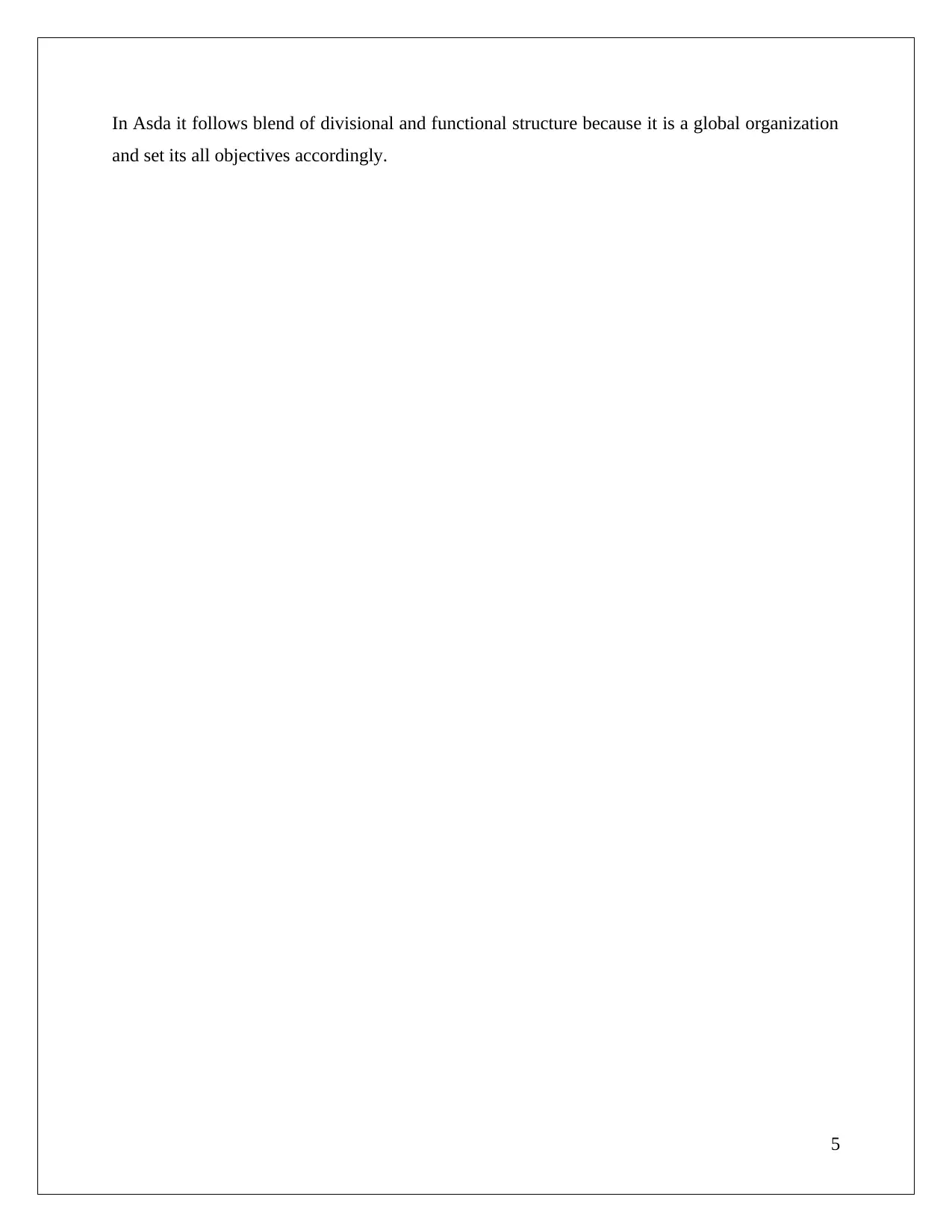
In Asda it follows blend of divisional and functional structure because it is a global organization
and set its all objectives accordingly.
5
and set its all objectives accordingly.
5
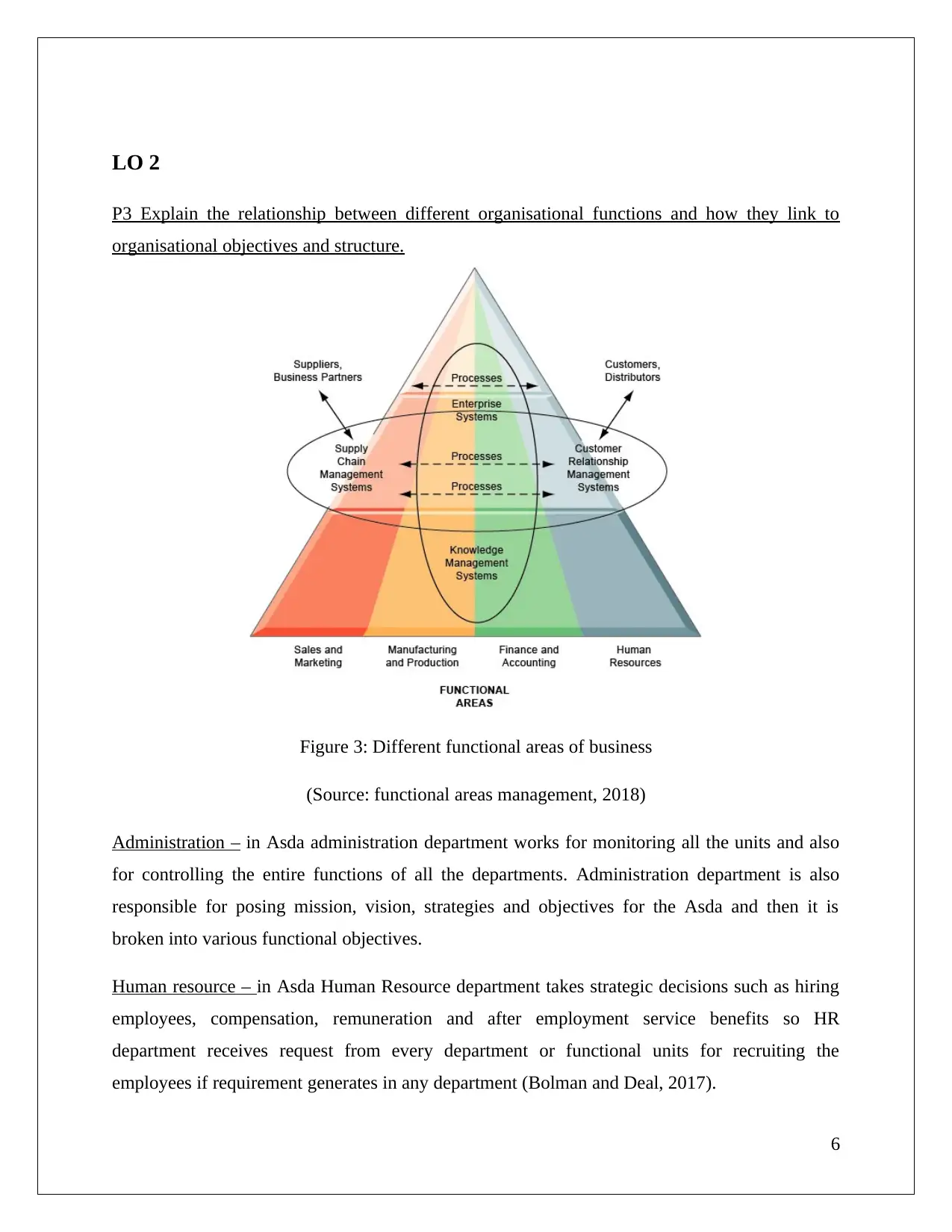
LO 2
P3 Explain the relationship between different organisational functions and how they link to
organisational objectives and structure.
Figure 3: Different functional areas of business
(Source: functional areas management, 2018)
Administration – in Asda administration department works for monitoring all the units and also
for controlling the entire functions of all the departments. Administration department is also
responsible for posing mission, vision, strategies and objectives for the Asda and then it is
broken into various functional objectives.
Human resource – in Asda Human Resource department takes strategic decisions such as hiring
employees, compensation, remuneration and after employment service benefits so HR
department receives request from every department or functional units for recruiting the
employees if requirement generates in any department (Bolman and Deal, 2017).
6
P3 Explain the relationship between different organisational functions and how they link to
organisational objectives and structure.
Figure 3: Different functional areas of business
(Source: functional areas management, 2018)
Administration – in Asda administration department works for monitoring all the units and also
for controlling the entire functions of all the departments. Administration department is also
responsible for posing mission, vision, strategies and objectives for the Asda and then it is
broken into various functional objectives.
Human resource – in Asda Human Resource department takes strategic decisions such as hiring
employees, compensation, remuneration and after employment service benefits so HR
department receives request from every department or functional units for recruiting the
employees if requirement generates in any department (Bolman and Deal, 2017).
6
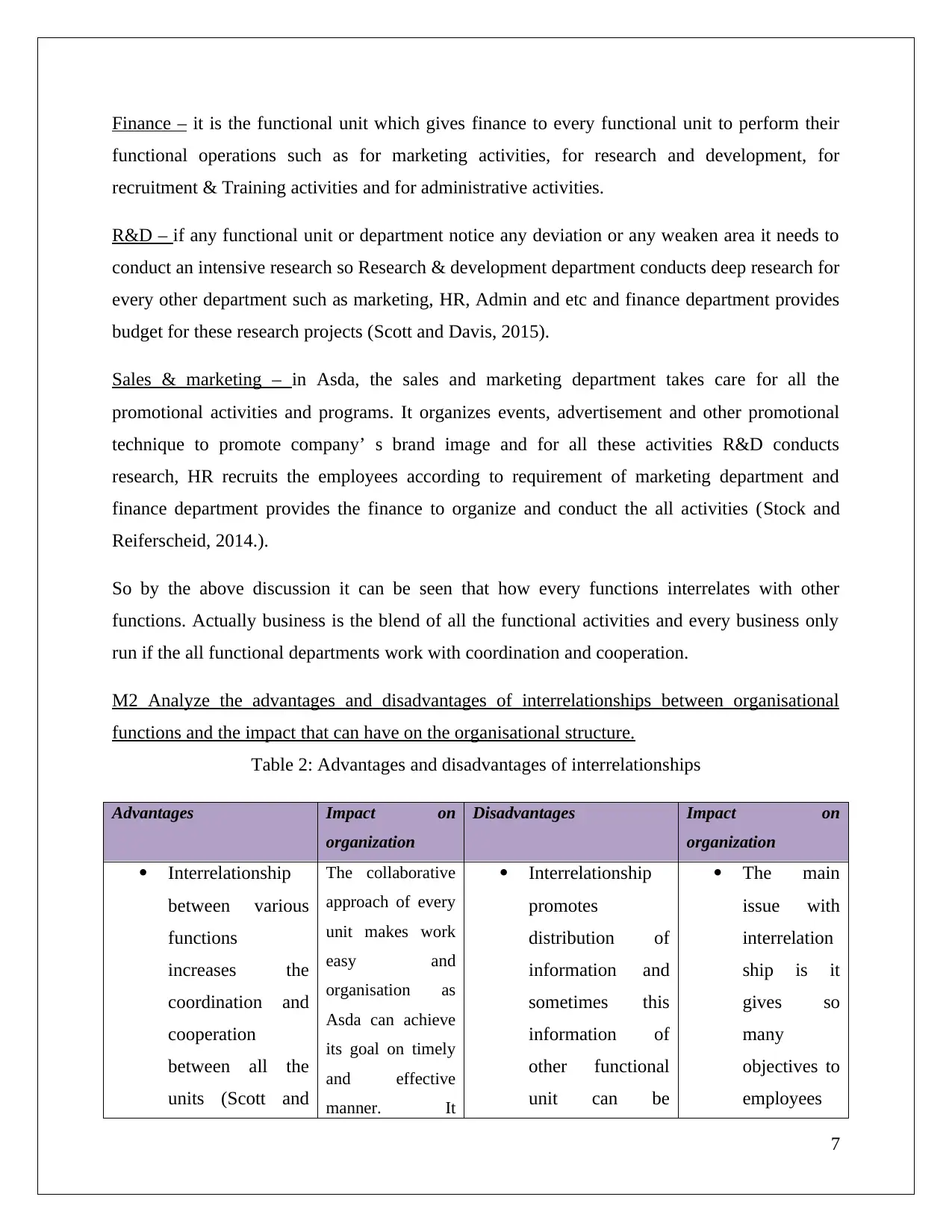
Finance – it is the functional unit which gives finance to every functional unit to perform their
functional operations such as for marketing activities, for research and development, for
recruitment & Training activities and for administrative activities.
R&D – if any functional unit or department notice any deviation or any weaken area it needs to
conduct an intensive research so Research & development department conducts deep research for
every other department such as marketing, HR, Admin and etc and finance department provides
budget for these research projects (Scott and Davis, 2015).
Sales & marketing – in Asda, the sales and marketing department takes care for all the
promotional activities and programs. It organizes events, advertisement and other promotional
technique to promote company’ s brand image and for all these activities R&D conducts
research, HR recruits the employees according to requirement of marketing department and
finance department provides the finance to organize and conduct the all activities (Stock and
Reiferscheid, 2014.).
So by the above discussion it can be seen that how every functions interrelates with other
functions. Actually business is the blend of all the functional activities and every business only
run if the all functional departments work with coordination and cooperation.
M2 Analyze the advantages and disadvantages of interrelationships between organisational
functions and the impact that can have on the organisational structure.
Table 2: Advantages and disadvantages of interrelationships
Advantages Impact on
organization
Disadvantages Impact on
organization
Interrelationship
between various
functions
increases the
coordination and
cooperation
between all the
units (Scott and
The collaborative
approach of every
unit makes work
easy and
organisation as
Asda can achieve
its goal on timely
and effective
manner. It
Interrelationship
promotes
distribution of
information and
sometimes this
information of
other functional
unit can be
The main
issue with
interrelation
ship is it
gives so
many
objectives to
employees
7
functional operations such as for marketing activities, for research and development, for
recruitment & Training activities and for administrative activities.
R&D – if any functional unit or department notice any deviation or any weaken area it needs to
conduct an intensive research so Research & development department conducts deep research for
every other department such as marketing, HR, Admin and etc and finance department provides
budget for these research projects (Scott and Davis, 2015).
Sales & marketing – in Asda, the sales and marketing department takes care for all the
promotional activities and programs. It organizes events, advertisement and other promotional
technique to promote company’ s brand image and for all these activities R&D conducts
research, HR recruits the employees according to requirement of marketing department and
finance department provides the finance to organize and conduct the all activities (Stock and
Reiferscheid, 2014.).
So by the above discussion it can be seen that how every functions interrelates with other
functions. Actually business is the blend of all the functional activities and every business only
run if the all functional departments work with coordination and cooperation.
M2 Analyze the advantages and disadvantages of interrelationships between organisational
functions and the impact that can have on the organisational structure.
Table 2: Advantages and disadvantages of interrelationships
Advantages Impact on
organization
Disadvantages Impact on
organization
Interrelationship
between various
functions
increases the
coordination and
cooperation
between all the
units (Scott and
The collaborative
approach of every
unit makes work
easy and
organisation as
Asda can achieve
its goal on timely
and effective
manner. It
Interrelationship
promotes
distribution of
information and
sometimes this
information of
other functional
unit can be
The main
issue with
interrelation
ship is it
gives so
many
objectives to
employees
7
Paraphrase This Document
Need a fresh take? Get an instant paraphrase of this document with our AI Paraphraser
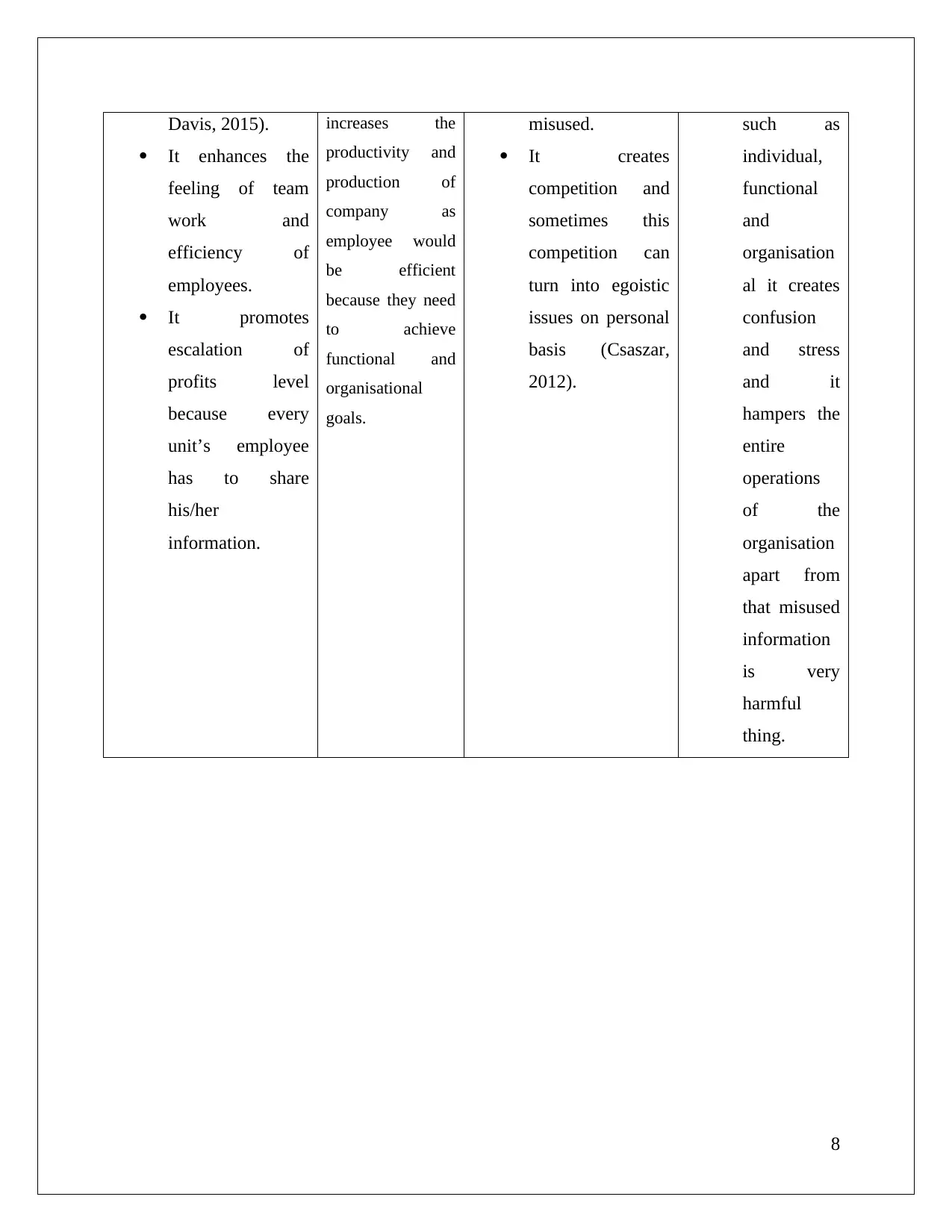
Davis, 2015).
It enhances the
feeling of team
work and
efficiency of
employees.
It promotes
escalation of
profits level
because every
unit’s employee
has to share
his/her
information.
increases the
productivity and
production of
company as
employee would
be efficient
because they need
to achieve
functional and
organisational
goals.
misused.
It creates
competition and
sometimes this
competition can
turn into egoistic
issues on personal
basis (Csaszar,
2012).
such as
individual,
functional
and
organisation
al it creates
confusion
and stress
and it
hampers the
entire
operations
of the
organisation
apart from
that misused
information
is very
harmful
thing.
8
It enhances the
feeling of team
work and
efficiency of
employees.
It promotes
escalation of
profits level
because every
unit’s employee
has to share
his/her
information.
increases the
productivity and
production of
company as
employee would
be efficient
because they need
to achieve
functional and
organisational
goals.
misused.
It creates
competition and
sometimes this
competition can
turn into egoistic
issues on personal
basis (Csaszar,
2012).
such as
individual,
functional
and
organisation
al it creates
confusion
and stress
and it
hampers the
entire
operations
of the
organisation
apart from
that misused
information
is very
harmful
thing.
8
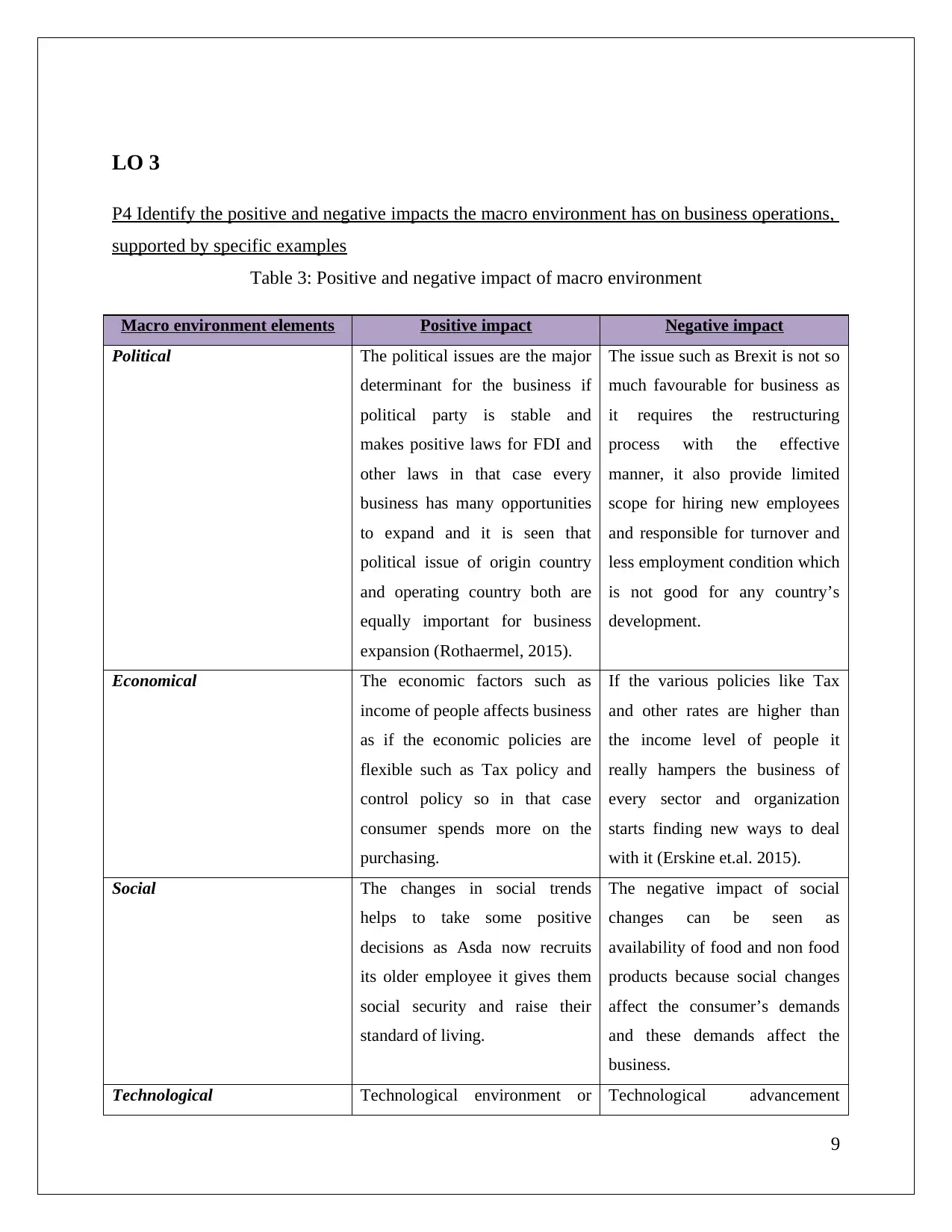
LO 3
P4 Identify the positive and negative impacts the macro environment has on business operations,
supported by specific examples
Table 3: Positive and negative impact of macro environment
Macro environment elements Positive impact Negative impact
Political The political issues are the major
determinant for the business if
political party is stable and
makes positive laws for FDI and
other laws in that case every
business has many opportunities
to expand and it is seen that
political issue of origin country
and operating country both are
equally important for business
expansion (Rothaermel, 2015).
The issue such as Brexit is not so
much favourable for business as
it requires the restructuring
process with the effective
manner, it also provide limited
scope for hiring new employees
and responsible for turnover and
less employment condition which
is not good for any country’s
development.
Economical The economic factors such as
income of people affects business
as if the economic policies are
flexible such as Tax policy and
control policy so in that case
consumer spends more on the
purchasing.
If the various policies like Tax
and other rates are higher than
the income level of people it
really hampers the business of
every sector and organization
starts finding new ways to deal
with it (Erskine et.al. 2015).
Social The changes in social trends
helps to take some positive
decisions as Asda now recruits
its older employee it gives them
social security and raise their
standard of living.
The negative impact of social
changes can be seen as
availability of food and non food
products because social changes
affect the consumer’s demands
and these demands affect the
business.
Technological Technological environment or Technological advancement
9
P4 Identify the positive and negative impacts the macro environment has on business operations,
supported by specific examples
Table 3: Positive and negative impact of macro environment
Macro environment elements Positive impact Negative impact
Political The political issues are the major
determinant for the business if
political party is stable and
makes positive laws for FDI and
other laws in that case every
business has many opportunities
to expand and it is seen that
political issue of origin country
and operating country both are
equally important for business
expansion (Rothaermel, 2015).
The issue such as Brexit is not so
much favourable for business as
it requires the restructuring
process with the effective
manner, it also provide limited
scope for hiring new employees
and responsible for turnover and
less employment condition which
is not good for any country’s
development.
Economical The economic factors such as
income of people affects business
as if the economic policies are
flexible such as Tax policy and
control policy so in that case
consumer spends more on the
purchasing.
If the various policies like Tax
and other rates are higher than
the income level of people it
really hampers the business of
every sector and organization
starts finding new ways to deal
with it (Erskine et.al. 2015).
Social The changes in social trends
helps to take some positive
decisions as Asda now recruits
its older employee it gives them
social security and raise their
standard of living.
The negative impact of social
changes can be seen as
availability of food and non food
products because social changes
affect the consumer’s demands
and these demands affect the
business.
Technological Technological environment or Technological advancement
9
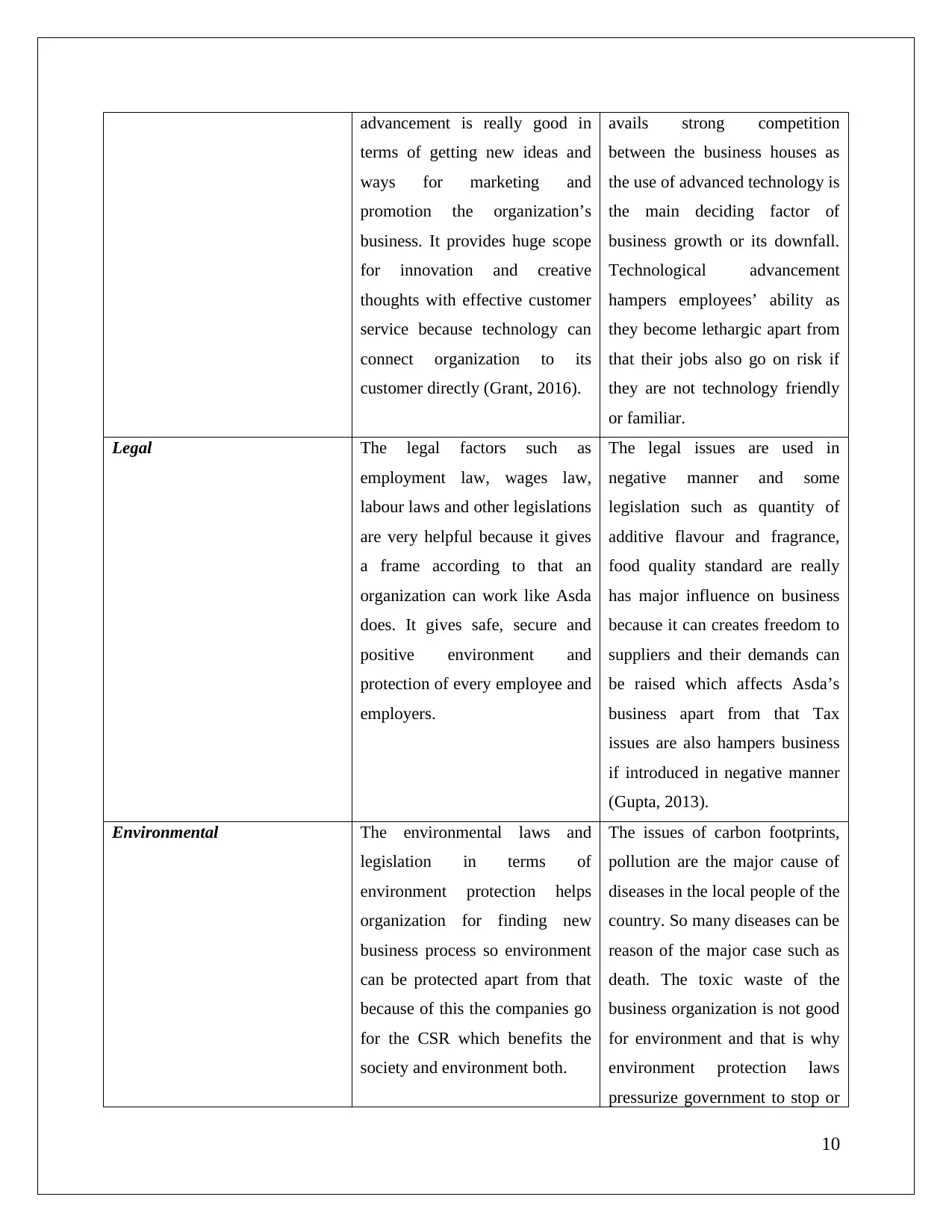
advancement is really good in
terms of getting new ideas and
ways for marketing and
promotion the organization’s
business. It provides huge scope
for innovation and creative
thoughts with effective customer
service because technology can
connect organization to its
customer directly (Grant, 2016).
avails strong competition
between the business houses as
the use of advanced technology is
the main deciding factor of
business growth or its downfall.
Technological advancement
hampers employees’ ability as
they become lethargic apart from
that their jobs also go on risk if
they are not technology friendly
or familiar.
Legal The legal factors such as
employment law, wages law,
labour laws and other legislations
are very helpful because it gives
a frame according to that an
organization can work like Asda
does. It gives safe, secure and
positive environment and
protection of every employee and
employers.
The legal issues are used in
negative manner and some
legislation such as quantity of
additive flavour and fragrance,
food quality standard are really
has major influence on business
because it can creates freedom to
suppliers and their demands can
be raised which affects Asda’s
business apart from that Tax
issues are also hampers business
if introduced in negative manner
(Gupta, 2013).
Environmental The environmental laws and
legislation in terms of
environment protection helps
organization for finding new
business process so environment
can be protected apart from that
because of this the companies go
for the CSR which benefits the
society and environment both.
The issues of carbon footprints,
pollution are the major cause of
diseases in the local people of the
country. So many diseases can be
reason of the major case such as
death. The toxic waste of the
business organization is not good
for environment and that is why
environment protection laws
pressurize government to stop or
10
terms of getting new ideas and
ways for marketing and
promotion the organization’s
business. It provides huge scope
for innovation and creative
thoughts with effective customer
service because technology can
connect organization to its
customer directly (Grant, 2016).
avails strong competition
between the business houses as
the use of advanced technology is
the main deciding factor of
business growth or its downfall.
Technological advancement
hampers employees’ ability as
they become lethargic apart from
that their jobs also go on risk if
they are not technology friendly
or familiar.
Legal The legal factors such as
employment law, wages law,
labour laws and other legislations
are very helpful because it gives
a frame according to that an
organization can work like Asda
does. It gives safe, secure and
positive environment and
protection of every employee and
employers.
The legal issues are used in
negative manner and some
legislation such as quantity of
additive flavour and fragrance,
food quality standard are really
has major influence on business
because it can creates freedom to
suppliers and their demands can
be raised which affects Asda’s
business apart from that Tax
issues are also hampers business
if introduced in negative manner
(Gupta, 2013).
Environmental The environmental laws and
legislation in terms of
environment protection helps
organization for finding new
business process so environment
can be protected apart from that
because of this the companies go
for the CSR which benefits the
society and environment both.
The issues of carbon footprints,
pollution are the major cause of
diseases in the local people of the
country. So many diseases can be
reason of the major case such as
death. The toxic waste of the
business organization is not good
for environment and that is why
environment protection laws
pressurize government to stop or
10
Secure Best Marks with AI Grader
Need help grading? Try our AI Grader for instant feedback on your assignments.
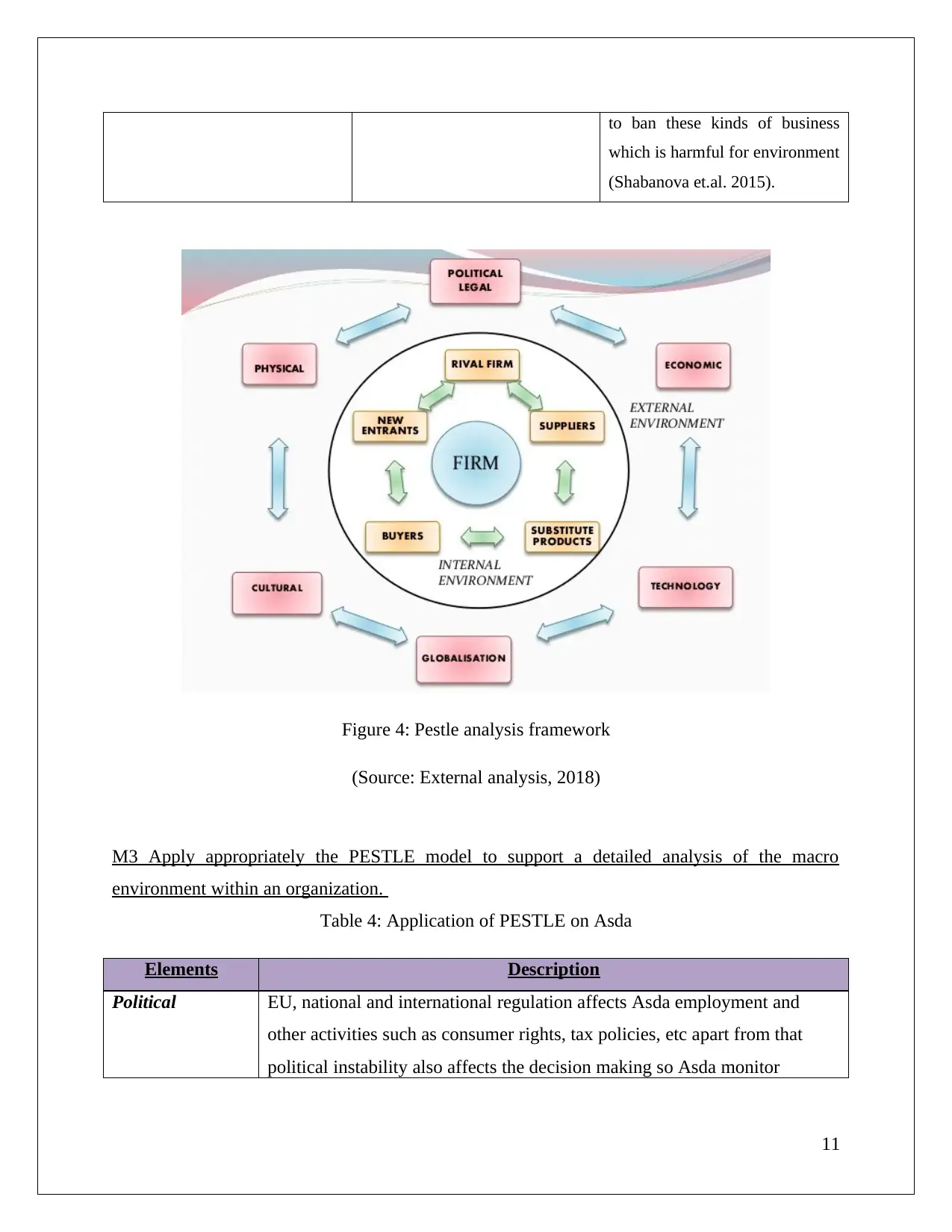
to ban these kinds of business
which is harmful for environment
(Shabanova et.al. 2015).
Figure 4: Pestle analysis framework
(Source: External analysis, 2018)
M3 Apply appropriately the PESTLE model to support a detailed analysis of the macro
environment within an organization.
Table 4: Application of PESTLE on Asda
Elements Description
Political EU, national and international regulation affects Asda employment and
other activities such as consumer rights, tax policies, etc apart from that
political instability also affects the decision making so Asda monitor
11
which is harmful for environment
(Shabanova et.al. 2015).
Figure 4: Pestle analysis framework
(Source: External analysis, 2018)
M3 Apply appropriately the PESTLE model to support a detailed analysis of the macro
environment within an organization.
Table 4: Application of PESTLE on Asda
Elements Description
Political EU, national and international regulation affects Asda employment and
other activities such as consumer rights, tax policies, etc apart from that
political instability also affects the decision making so Asda monitor
11
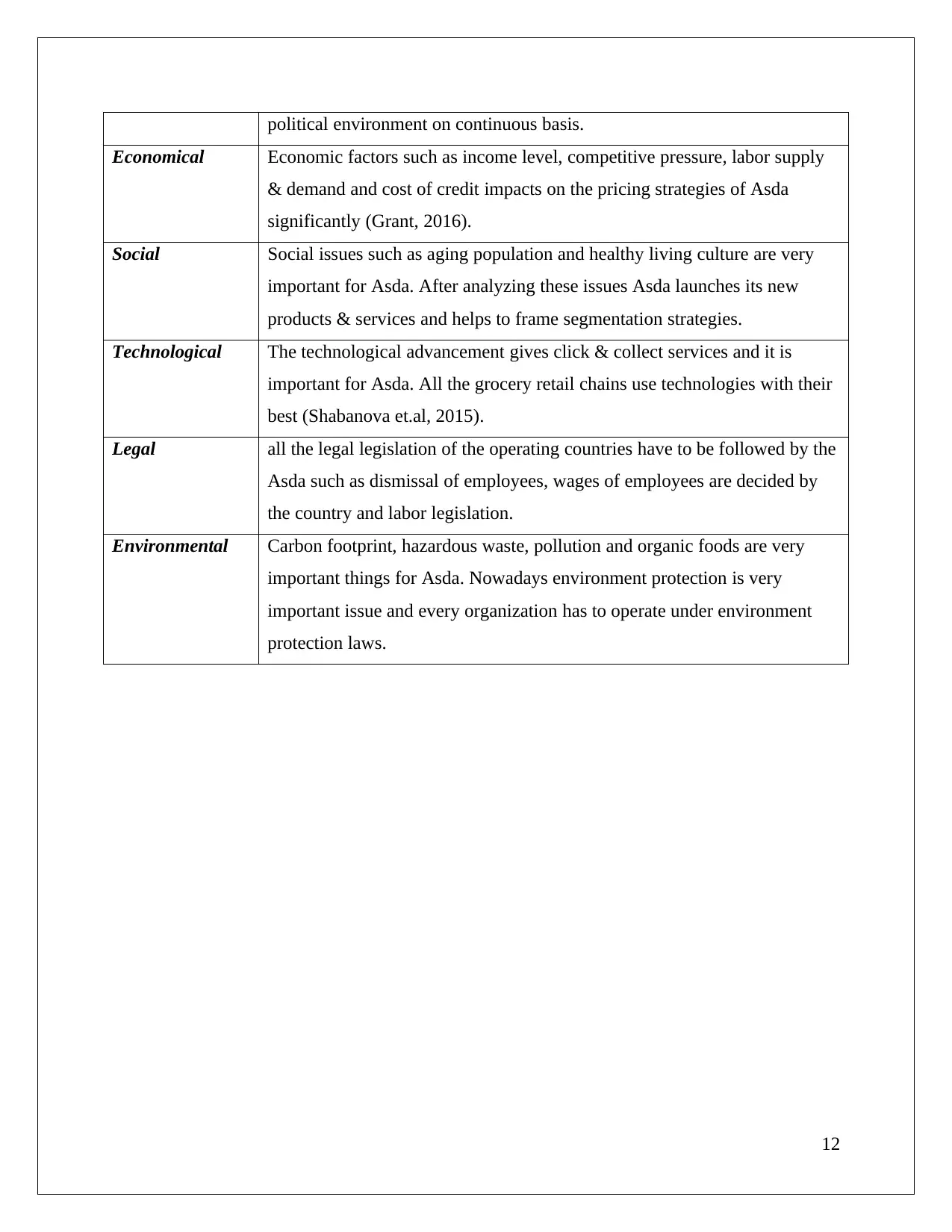
political environment on continuous basis.
Economical Economic factors such as income level, competitive pressure, labor supply
& demand and cost of credit impacts on the pricing strategies of Asda
significantly (Grant, 2016).
Social Social issues such as aging population and healthy living culture are very
important for Asda. After analyzing these issues Asda launches its new
products & services and helps to frame segmentation strategies.
Technological The technological advancement gives click & collect services and it is
important for Asda. All the grocery retail chains use technologies with their
best (Shabanova et.al, 2015).
Legal all the legal legislation of the operating countries have to be followed by the
Asda such as dismissal of employees, wages of employees are decided by
the country and labor legislation.
Environmental Carbon footprint, hazardous waste, pollution and organic foods are very
important things for Asda. Nowadays environment protection is very
important issue and every organization has to operate under environment
protection laws.
12
Economical Economic factors such as income level, competitive pressure, labor supply
& demand and cost of credit impacts on the pricing strategies of Asda
significantly (Grant, 2016).
Social Social issues such as aging population and healthy living culture are very
important for Asda. After analyzing these issues Asda launches its new
products & services and helps to frame segmentation strategies.
Technological The technological advancement gives click & collect services and it is
important for Asda. All the grocery retail chains use technologies with their
best (Shabanova et.al, 2015).
Legal all the legal legislation of the operating countries have to be followed by the
Asda such as dismissal of employees, wages of employees are decided by
the country and labor legislation.
Environmental Carbon footprint, hazardous waste, pollution and organic foods are very
important things for Asda. Nowadays environment protection is very
important issue and every organization has to operate under environment
protection laws.
12
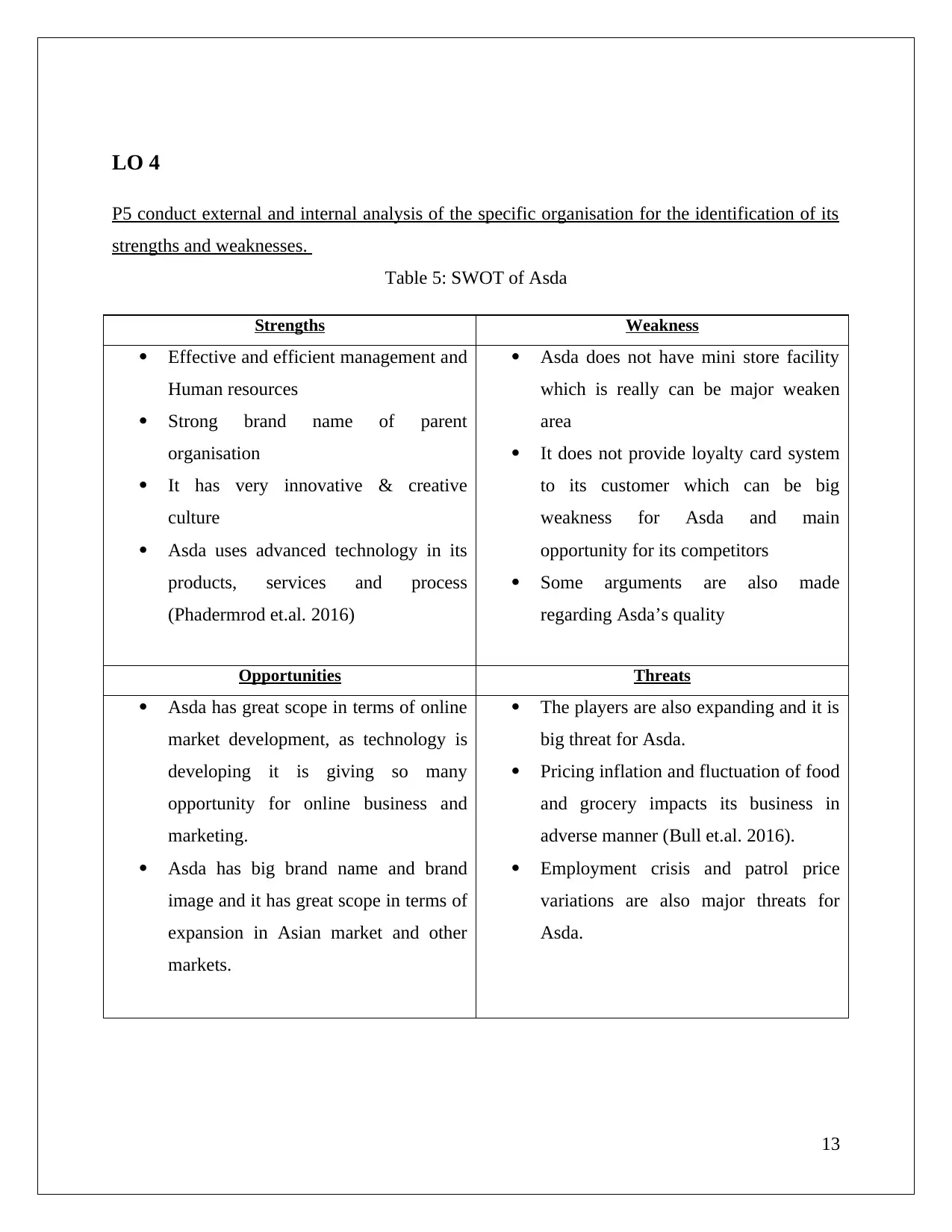
LO 4
P5 conduct external and internal analysis of the specific organisation for the identification of its
strengths and weaknesses.
Table 5: SWOT of Asda
Strengths Weakness
Effective and efficient management and
Human resources
Strong brand name of parent
organisation
It has very innovative & creative
culture
Asda uses advanced technology in its
products, services and process
(Phadermrod et.al. 2016)
Asda does not have mini store facility
which is really can be major weaken
area
It does not provide loyalty card system
to its customer which can be big
weakness for Asda and main
opportunity for its competitors
Some arguments are also made
regarding Asda’s quality
Opportunities Threats
Asda has great scope in terms of online
market development, as technology is
developing it is giving so many
opportunity for online business and
marketing.
Asda has big brand name and brand
image and it has great scope in terms of
expansion in Asian market and other
markets.
The players are also expanding and it is
big threat for Asda.
Pricing inflation and fluctuation of food
and grocery impacts its business in
adverse manner (Bull et.al. 2016).
Employment crisis and patrol price
variations are also major threats for
Asda.
13
P5 conduct external and internal analysis of the specific organisation for the identification of its
strengths and weaknesses.
Table 5: SWOT of Asda
Strengths Weakness
Effective and efficient management and
Human resources
Strong brand name of parent
organisation
It has very innovative & creative
culture
Asda uses advanced technology in its
products, services and process
(Phadermrod et.al. 2016)
Asda does not have mini store facility
which is really can be major weaken
area
It does not provide loyalty card system
to its customer which can be big
weakness for Asda and main
opportunity for its competitors
Some arguments are also made
regarding Asda’s quality
Opportunities Threats
Asda has great scope in terms of online
market development, as technology is
developing it is giving so many
opportunity for online business and
marketing.
Asda has big brand name and brand
image and it has great scope in terms of
expansion in Asian market and other
markets.
The players are also expanding and it is
big threat for Asda.
Pricing inflation and fluctuation of food
and grocery impacts its business in
adverse manner (Bull et.al. 2016).
Employment crisis and patrol price
variations are also major threats for
Asda.
13
Paraphrase This Document
Need a fresh take? Get an instant paraphrase of this document with our AI Paraphraser
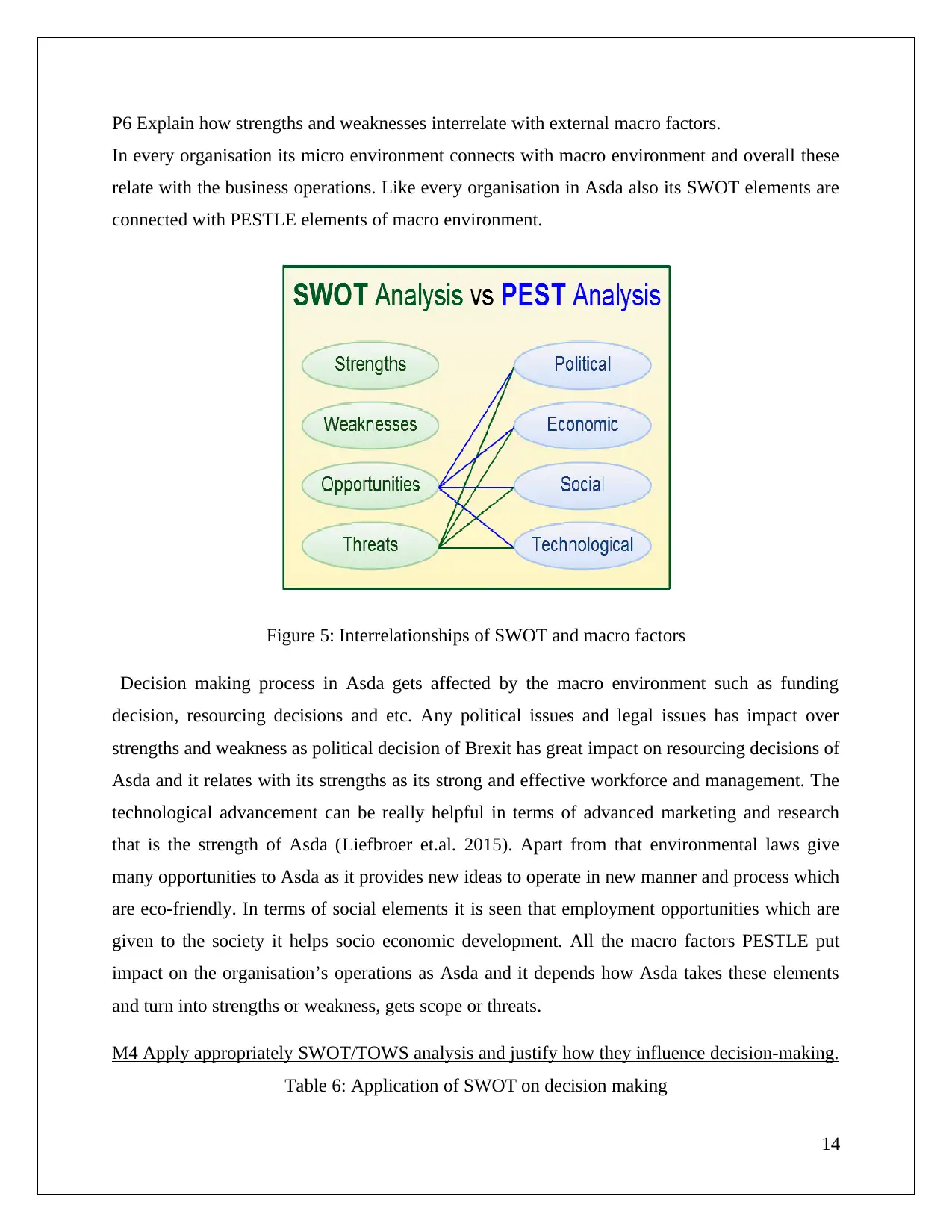
P6 Explain how strengths and weaknesses interrelate with external macro factors.
In every organisation its micro environment connects with macro environment and overall these
relate with the business operations. Like every organisation in Asda also its SWOT elements are
connected with PESTLE elements of macro environment.
Figure 5: Interrelationships of SWOT and macro factors
Decision making process in Asda gets affected by the macro environment such as funding
decision, resourcing decisions and etc. Any political issues and legal issues has impact over
strengths and weakness as political decision of Brexit has great impact on resourcing decisions of
Asda and it relates with its strengths as its strong and effective workforce and management. The
technological advancement can be really helpful in terms of advanced marketing and research
that is the strength of Asda (Liefbroer et.al. 2015). Apart from that environmental laws give
many opportunities to Asda as it provides new ideas to operate in new manner and process which
are eco-friendly. In terms of social elements it is seen that employment opportunities which are
given to the society it helps socio economic development. All the macro factors PESTLE put
impact on the organisation’s operations as Asda and it depends how Asda takes these elements
and turn into strengths or weakness, gets scope or threats.
M4 Apply appropriately SWOT/TOWS analysis and justify how they influence decision-making.
Table 6: Application of SWOT on decision making
14
In every organisation its micro environment connects with macro environment and overall these
relate with the business operations. Like every organisation in Asda also its SWOT elements are
connected with PESTLE elements of macro environment.
Figure 5: Interrelationships of SWOT and macro factors
Decision making process in Asda gets affected by the macro environment such as funding
decision, resourcing decisions and etc. Any political issues and legal issues has impact over
strengths and weakness as political decision of Brexit has great impact on resourcing decisions of
Asda and it relates with its strengths as its strong and effective workforce and management. The
technological advancement can be really helpful in terms of advanced marketing and research
that is the strength of Asda (Liefbroer et.al. 2015). Apart from that environmental laws give
many opportunities to Asda as it provides new ideas to operate in new manner and process which
are eco-friendly. In terms of social elements it is seen that employment opportunities which are
given to the society it helps socio economic development. All the macro factors PESTLE put
impact on the organisation’s operations as Asda and it depends how Asda takes these elements
and turn into strengths or weakness, gets scope or threats.
M4 Apply appropriately SWOT/TOWS analysis and justify how they influence decision-making.
Table 6: Application of SWOT on decision making
14
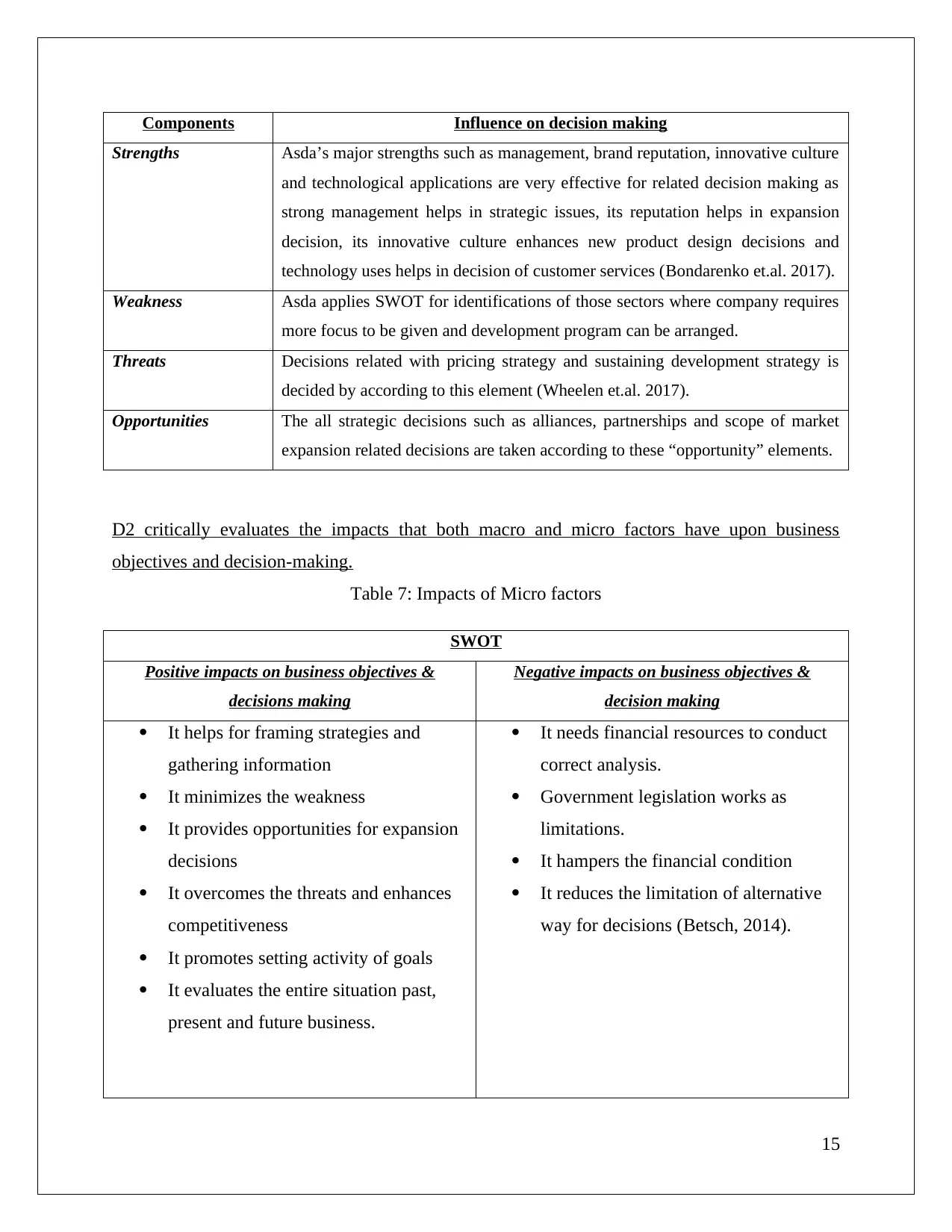
Components Influence on decision making
Strengths Asda’s major strengths such as management, brand reputation, innovative culture
and technological applications are very effective for related decision making as
strong management helps in strategic issues, its reputation helps in expansion
decision, its innovative culture enhances new product design decisions and
technology uses helps in decision of customer services (Bondarenko et.al. 2017).
Weakness Asda applies SWOT for identifications of those sectors where company requires
more focus to be given and development program can be arranged.
Threats Decisions related with pricing strategy and sustaining development strategy is
decided by according to this element (Wheelen et.al. 2017).
Opportunities The all strategic decisions such as alliances, partnerships and scope of market
expansion related decisions are taken according to these “opportunity” elements.
D2 critically evaluates the impacts that both macro and micro factors have upon business
objectives and decision-making.
Table 7: Impacts of Micro factors
SWOT
Positive impacts on business objectives &
decisions making
Negative impacts on business objectives &
decision making
It helps for framing strategies and
gathering information
It minimizes the weakness
It provides opportunities for expansion
decisions
It overcomes the threats and enhances
competitiveness
It promotes setting activity of goals
It evaluates the entire situation past,
present and future business.
It needs financial resources to conduct
correct analysis.
Government legislation works as
limitations.
It hampers the financial condition
It reduces the limitation of alternative
way for decisions (Betsch, 2014).
15
Strengths Asda’s major strengths such as management, brand reputation, innovative culture
and technological applications are very effective for related decision making as
strong management helps in strategic issues, its reputation helps in expansion
decision, its innovative culture enhances new product design decisions and
technology uses helps in decision of customer services (Bondarenko et.al. 2017).
Weakness Asda applies SWOT for identifications of those sectors where company requires
more focus to be given and development program can be arranged.
Threats Decisions related with pricing strategy and sustaining development strategy is
decided by according to this element (Wheelen et.al. 2017).
Opportunities The all strategic decisions such as alliances, partnerships and scope of market
expansion related decisions are taken according to these “opportunity” elements.
D2 critically evaluates the impacts that both macro and micro factors have upon business
objectives and decision-making.
Table 7: Impacts of Micro factors
SWOT
Positive impacts on business objectives &
decisions making
Negative impacts on business objectives &
decision making
It helps for framing strategies and
gathering information
It minimizes the weakness
It provides opportunities for expansion
decisions
It overcomes the threats and enhances
competitiveness
It promotes setting activity of goals
It evaluates the entire situation past,
present and future business.
It needs financial resources to conduct
correct analysis.
Government legislation works as
limitations.
It hampers the financial condition
It reduces the limitation of alternative
way for decisions (Betsch, 2014).
15
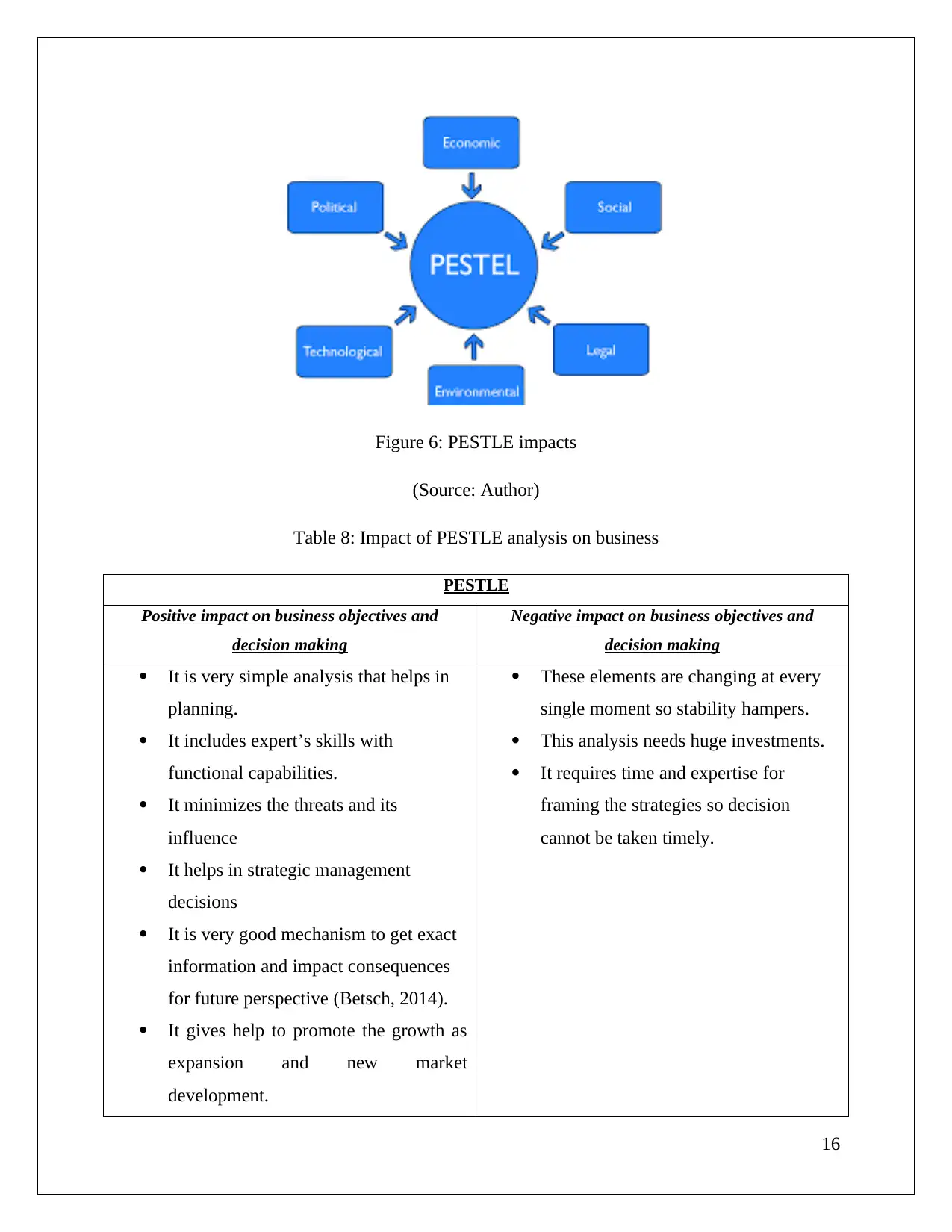
Figure 6: PESTLE impacts
(Source: Author)
Table 8: Impact of PESTLE analysis on business
PESTLE
Positive impact on business objectives and
decision making
Negative impact on business objectives and
decision making
It is very simple analysis that helps in
planning.
It includes expert’s skills with
functional capabilities.
It minimizes the threats and its
influence
It helps in strategic management
decisions
It is very good mechanism to get exact
information and impact consequences
for future perspective (Betsch, 2014).
It gives help to promote the growth as
expansion and new market
development.
These elements are changing at every
single moment so stability hampers.
This analysis needs huge investments.
It requires time and expertise for
framing the strategies so decision
cannot be taken timely.
16
(Source: Author)
Table 8: Impact of PESTLE analysis on business
PESTLE
Positive impact on business objectives and
decision making
Negative impact on business objectives and
decision making
It is very simple analysis that helps in
planning.
It includes expert’s skills with
functional capabilities.
It minimizes the threats and its
influence
It helps in strategic management
decisions
It is very good mechanism to get exact
information and impact consequences
for future perspective (Betsch, 2014).
It gives help to promote the growth as
expansion and new market
development.
These elements are changing at every
single moment so stability hampers.
This analysis needs huge investments.
It requires time and expertise for
framing the strategies so decision
cannot be taken timely.
16
Secure Best Marks with AI Grader
Need help grading? Try our AI Grader for instant feedback on your assignments.

17
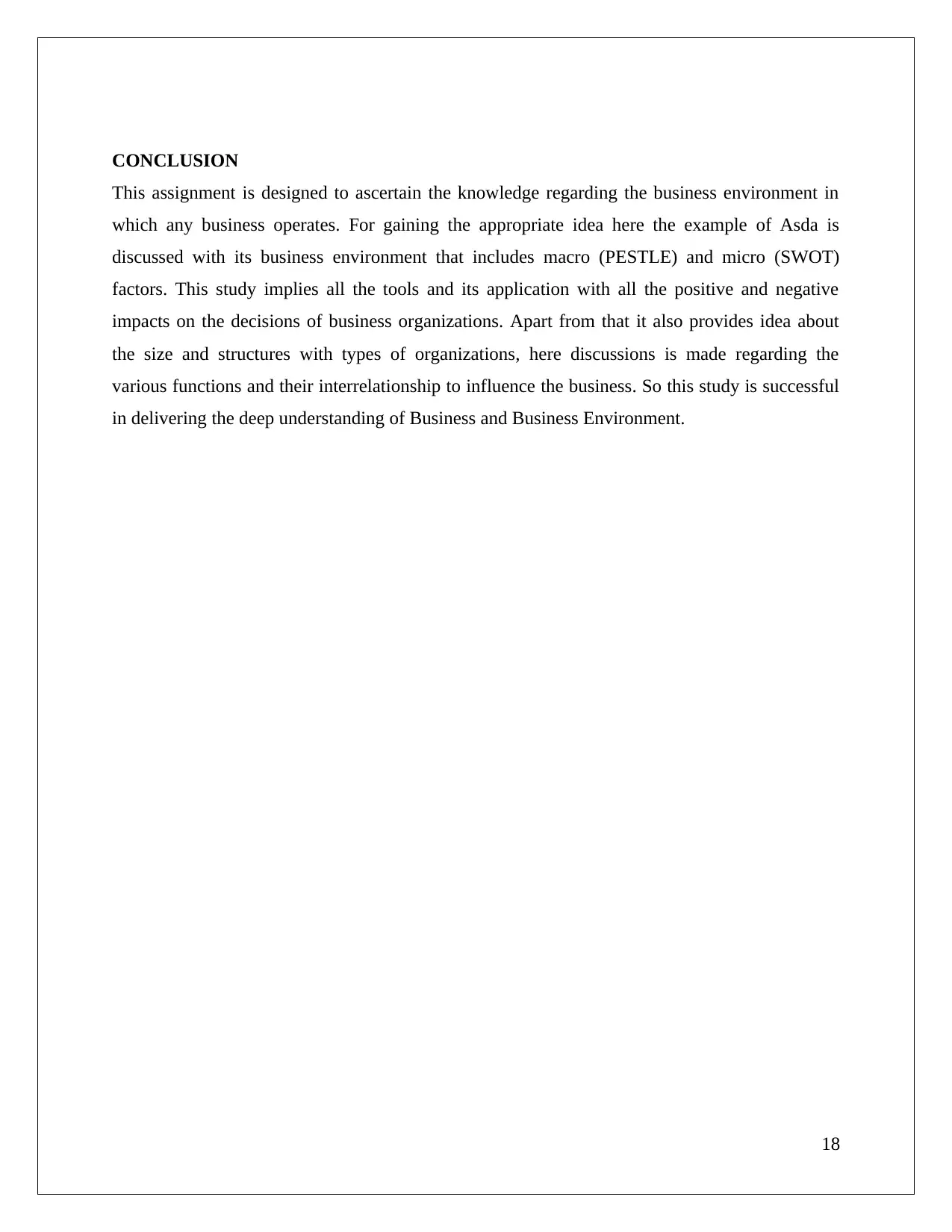
CONCLUSION
This assignment is designed to ascertain the knowledge regarding the business environment in
which any business operates. For gaining the appropriate idea here the example of Asda is
discussed with its business environment that includes macro (PESTLE) and micro (SWOT)
factors. This study implies all the tools and its application with all the positive and negative
impacts on the decisions of business organizations. Apart from that it also provides idea about
the size and structures with types of organizations, here discussions is made regarding the
various functions and their interrelationship to influence the business. So this study is successful
in delivering the deep understanding of Business and Business Environment.
18
This assignment is designed to ascertain the knowledge regarding the business environment in
which any business operates. For gaining the appropriate idea here the example of Asda is
discussed with its business environment that includes macro (PESTLE) and micro (SWOT)
factors. This study implies all the tools and its application with all the positive and negative
impacts on the decisions of business organizations. Apart from that it also provides idea about
the size and structures with types of organizations, here discussions is made regarding the
various functions and their interrelationship to influence the business. So this study is successful
in delivering the deep understanding of Business and Business Environment.
18
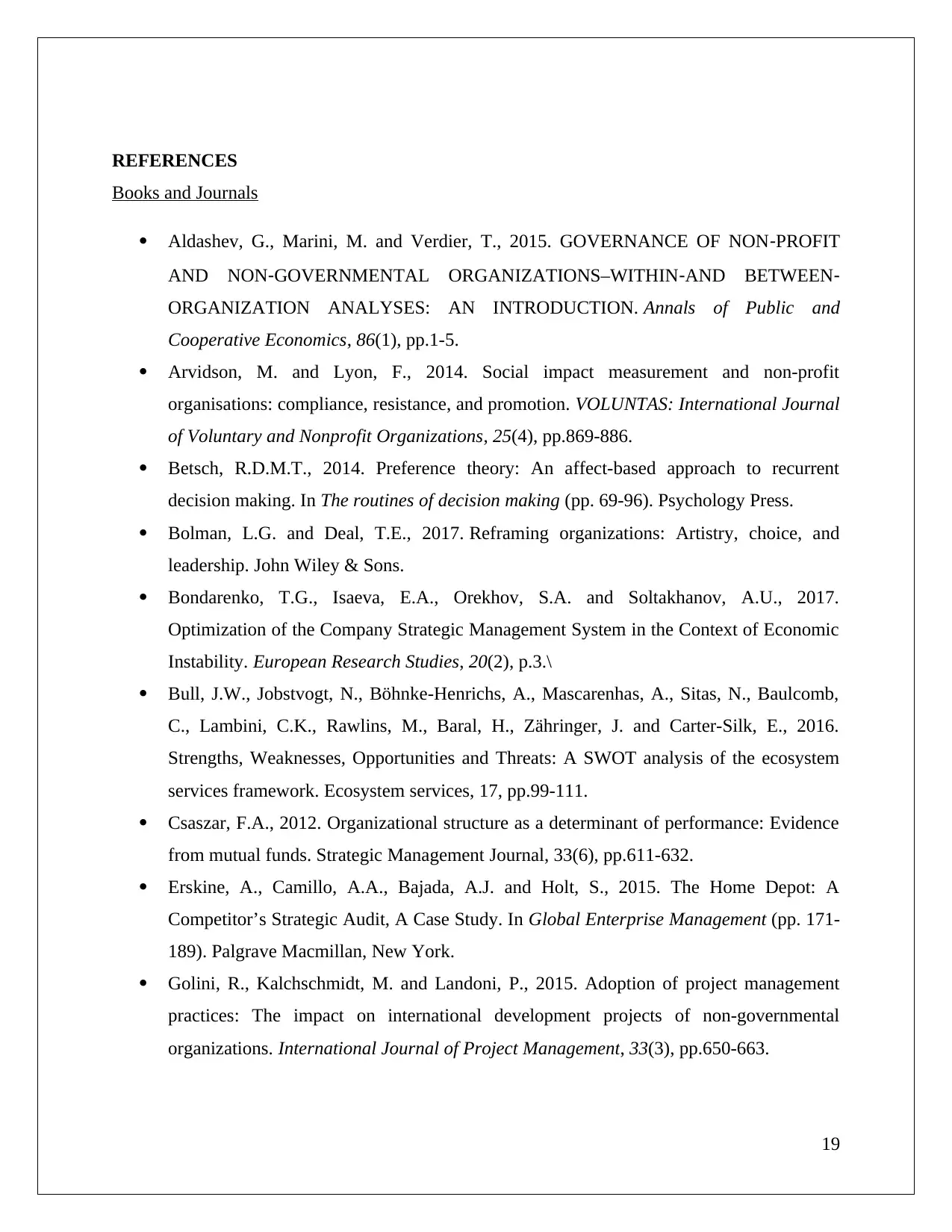
REFERENCES
Books and Journals
Aldashev, G., Marini, M. and Verdier, T., 2015. GOVERNANCE OF NON‐PROFIT
AND NON‐GOVERNMENTAL ORGANIZATIONS–WITHIN‐AND BETWEEN‐
ORGANIZATION ANALYSES: AN INTRODUCTION. Annals of Public and
Cooperative Economics, 86(1), pp.1-5.
Arvidson, M. and Lyon, F., 2014. Social impact measurement and non-profit
organisations: compliance, resistance, and promotion. VOLUNTAS: International Journal
of Voluntary and Nonprofit Organizations, 25(4), pp.869-886.
Betsch, R.D.M.T., 2014. Preference theory: An affect-based approach to recurrent
decision making. In The routines of decision making (pp. 69-96). Psychology Press.
Bolman, L.G. and Deal, T.E., 2017. Reframing organizations: Artistry, choice, and
leadership. John Wiley & Sons.
Bondarenko, T.G., Isaeva, E.A., Orekhov, S.A. and Soltakhanov, A.U., 2017.
Optimization of the Company Strategic Management System in the Context of Economic
Instability. European Research Studies, 20(2), p.3.\
Bull, J.W., Jobstvogt, N., Böhnke-Henrichs, A., Mascarenhas, A., Sitas, N., Baulcomb,
C., Lambini, C.K., Rawlins, M., Baral, H., Zähringer, J. and Carter-Silk, E., 2016.
Strengths, Weaknesses, Opportunities and Threats: A SWOT analysis of the ecosystem
services framework. Ecosystem services, 17, pp.99-111.
Csaszar, F.A., 2012. Organizational structure as a determinant of performance: Evidence
from mutual funds. Strategic Management Journal, 33(6), pp.611-632.
Erskine, A., Camillo, A.A., Bajada, A.J. and Holt, S., 2015. The Home Depot: A
Competitor’s Strategic Audit, A Case Study. In Global Enterprise Management (pp. 171-
189). Palgrave Macmillan, New York.
Golini, R., Kalchschmidt, M. and Landoni, P., 2015. Adoption of project management
practices: The impact on international development projects of non-governmental
organizations. International Journal of Project Management, 33(3), pp.650-663.
19
Books and Journals
Aldashev, G., Marini, M. and Verdier, T., 2015. GOVERNANCE OF NON‐PROFIT
AND NON‐GOVERNMENTAL ORGANIZATIONS–WITHIN‐AND BETWEEN‐
ORGANIZATION ANALYSES: AN INTRODUCTION. Annals of Public and
Cooperative Economics, 86(1), pp.1-5.
Arvidson, M. and Lyon, F., 2014. Social impact measurement and non-profit
organisations: compliance, resistance, and promotion. VOLUNTAS: International Journal
of Voluntary and Nonprofit Organizations, 25(4), pp.869-886.
Betsch, R.D.M.T., 2014. Preference theory: An affect-based approach to recurrent
decision making. In The routines of decision making (pp. 69-96). Psychology Press.
Bolman, L.G. and Deal, T.E., 2017. Reframing organizations: Artistry, choice, and
leadership. John Wiley & Sons.
Bondarenko, T.G., Isaeva, E.A., Orekhov, S.A. and Soltakhanov, A.U., 2017.
Optimization of the Company Strategic Management System in the Context of Economic
Instability. European Research Studies, 20(2), p.3.\
Bull, J.W., Jobstvogt, N., Böhnke-Henrichs, A., Mascarenhas, A., Sitas, N., Baulcomb,
C., Lambini, C.K., Rawlins, M., Baral, H., Zähringer, J. and Carter-Silk, E., 2016.
Strengths, Weaknesses, Opportunities and Threats: A SWOT analysis of the ecosystem
services framework. Ecosystem services, 17, pp.99-111.
Csaszar, F.A., 2012. Organizational structure as a determinant of performance: Evidence
from mutual funds. Strategic Management Journal, 33(6), pp.611-632.
Erskine, A., Camillo, A.A., Bajada, A.J. and Holt, S., 2015. The Home Depot: A
Competitor’s Strategic Audit, A Case Study. In Global Enterprise Management (pp. 171-
189). Palgrave Macmillan, New York.
Golini, R., Kalchschmidt, M. and Landoni, P., 2015. Adoption of project management
practices: The impact on international development projects of non-governmental
organizations. International Journal of Project Management, 33(3), pp.650-663.
19
Paraphrase This Document
Need a fresh take? Get an instant paraphrase of this document with our AI Paraphraser
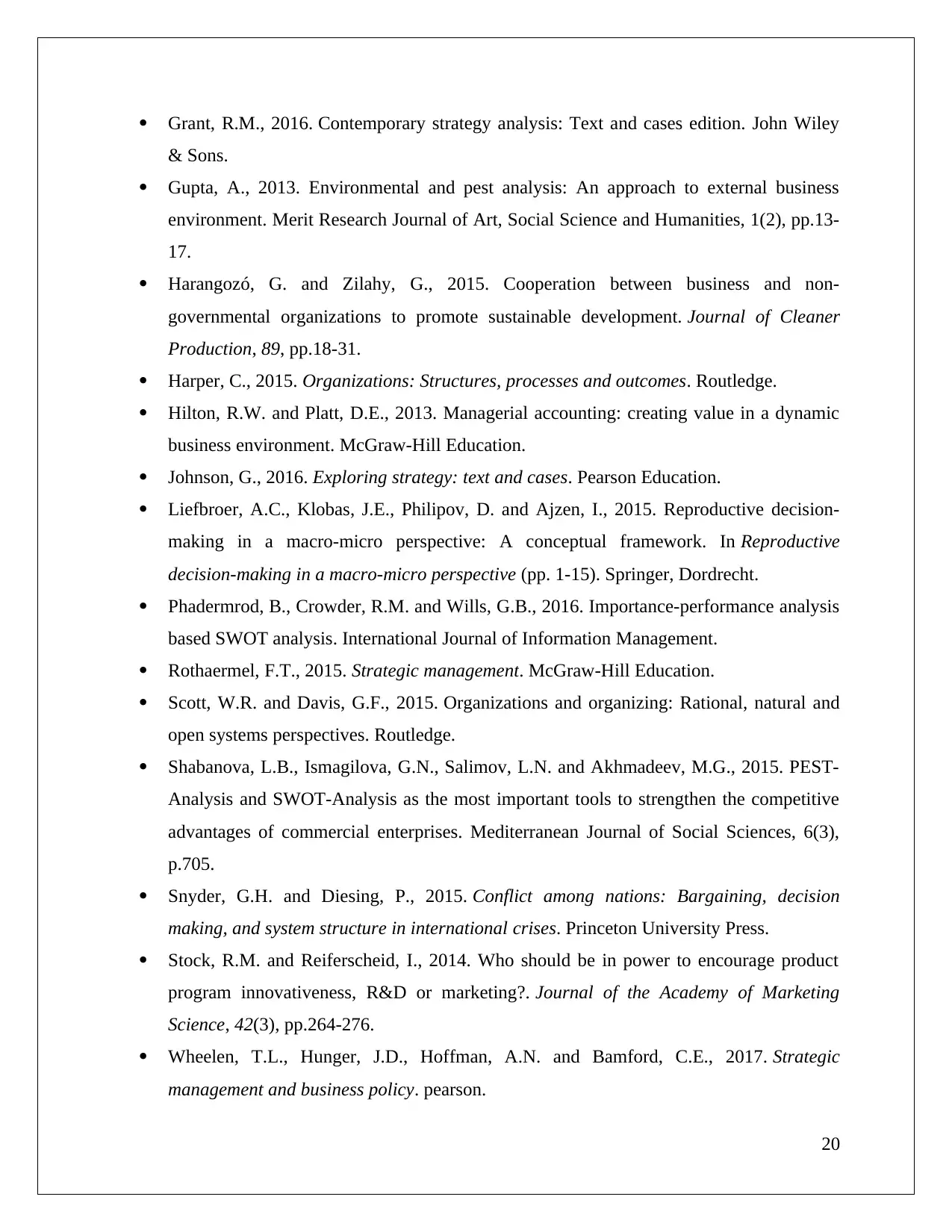
Grant, R.M., 2016. Contemporary strategy analysis: Text and cases edition. John Wiley
& Sons.
Gupta, A., 2013. Environmental and pest analysis: An approach to external business
environment. Merit Research Journal of Art, Social Science and Humanities, 1(2), pp.13-
17.
Harangozó, G. and Zilahy, G., 2015. Cooperation between business and non-
governmental organizations to promote sustainable development. Journal of Cleaner
Production, 89, pp.18-31.
Harper, C., 2015. Organizations: Structures, processes and outcomes. Routledge.
Hilton, R.W. and Platt, D.E., 2013. Managerial accounting: creating value in a dynamic
business environment. McGraw-Hill Education.
Johnson, G., 2016. Exploring strategy: text and cases. Pearson Education.
Liefbroer, A.C., Klobas, J.E., Philipov, D. and Ajzen, I., 2015. Reproductive decision-
making in a macro-micro perspective: A conceptual framework. In Reproductive
decision-making in a macro-micro perspective (pp. 1-15). Springer, Dordrecht.
Phadermrod, B., Crowder, R.M. and Wills, G.B., 2016. Importance-performance analysis
based SWOT analysis. International Journal of Information Management.
Rothaermel, F.T., 2015. Strategic management. McGraw-Hill Education.
Scott, W.R. and Davis, G.F., 2015. Organizations and organizing: Rational, natural and
open systems perspectives. Routledge.
Shabanova, L.B., Ismagilova, G.N., Salimov, L.N. and Akhmadeev, M.G., 2015. PEST-
Analysis and SWOT-Analysis as the most important tools to strengthen the competitive
advantages of commercial enterprises. Mediterranean Journal of Social Sciences, 6(3),
p.705.
Snyder, G.H. and Diesing, P., 2015. Conflict among nations: Bargaining, decision
making, and system structure in international crises. Princeton University Press.
Stock, R.M. and Reiferscheid, I., 2014. Who should be in power to encourage product
program innovativeness, R&D or marketing?. Journal of the Academy of Marketing
Science, 42(3), pp.264-276.
Wheelen, T.L., Hunger, J.D., Hoffman, A.N. and Bamford, C.E., 2017. Strategic
management and business policy. pearson.
20
& Sons.
Gupta, A., 2013. Environmental and pest analysis: An approach to external business
environment. Merit Research Journal of Art, Social Science and Humanities, 1(2), pp.13-
17.
Harangozó, G. and Zilahy, G., 2015. Cooperation between business and non-
governmental organizations to promote sustainable development. Journal of Cleaner
Production, 89, pp.18-31.
Harper, C., 2015. Organizations: Structures, processes and outcomes. Routledge.
Hilton, R.W. and Platt, D.E., 2013. Managerial accounting: creating value in a dynamic
business environment. McGraw-Hill Education.
Johnson, G., 2016. Exploring strategy: text and cases. Pearson Education.
Liefbroer, A.C., Klobas, J.E., Philipov, D. and Ajzen, I., 2015. Reproductive decision-
making in a macro-micro perspective: A conceptual framework. In Reproductive
decision-making in a macro-micro perspective (pp. 1-15). Springer, Dordrecht.
Phadermrod, B., Crowder, R.M. and Wills, G.B., 2016. Importance-performance analysis
based SWOT analysis. International Journal of Information Management.
Rothaermel, F.T., 2015. Strategic management. McGraw-Hill Education.
Scott, W.R. and Davis, G.F., 2015. Organizations and organizing: Rational, natural and
open systems perspectives. Routledge.
Shabanova, L.B., Ismagilova, G.N., Salimov, L.N. and Akhmadeev, M.G., 2015. PEST-
Analysis and SWOT-Analysis as the most important tools to strengthen the competitive
advantages of commercial enterprises. Mediterranean Journal of Social Sciences, 6(3),
p.705.
Snyder, G.H. and Diesing, P., 2015. Conflict among nations: Bargaining, decision
making, and system structure in international crises. Princeton University Press.
Stock, R.M. and Reiferscheid, I., 2014. Who should be in power to encourage product
program innovativeness, R&D or marketing?. Journal of the Academy of Marketing
Science, 42(3), pp.264-276.
Wheelen, T.L., Hunger, J.D., Hoffman, A.N. and Bamford, C.E., 2017. Strategic
management and business policy. pearson.
20

21
1 out of 27
Related Documents
Your All-in-One AI-Powered Toolkit for Academic Success.
+13062052269
info@desklib.com
Available 24*7 on WhatsApp / Email
![[object Object]](/_next/static/media/star-bottom.7253800d.svg)
Unlock your academic potential
© 2024 | Zucol Services PVT LTD | All rights reserved.





